Madagascar: A World Apart Photography Tour Report 2022
17 December 2022





























































































































Grandidier’s Baobab sunrise at Kirindy (image by Mike Watson)

Heteropsis fraterna butterfly at Le Palmarium (image by Mike Watson)

White-breasted Mesite is a denizen of the dry deciduous forest of western Madagascar (image by Mike Watson)

Pitcher plants growing in profusion at Le Palmarium (image by Mike Watson)

Pale Fork-marked Lemur on a night walk in Kirindy Forest (image by Mike Watson)

The white beaches and (usually) blue skies of Le Palmarium (image by Mike Watson)

Diademed Sifaka at Analamazoatra (image by Mike Watson)

Indri at Analamazoatra – no visit to Madagascar would be complete without seeing this amazing animal (image by Mike Watson)

The National Park forest strip at Zombitse only covers 16,845 hectares and holds an endemic bird and a lemur! (image by Mike Watson)

Oustalet’s Chameleon at Kirindy Forest. The grey presenting ones sometimes get called as Spiny | Warty Chameleons but there’s no daylight between the dorsal spines on this (image by Mike Watson)

Giant Coua on the foerest floor at Zombitse (image by Mike Watson)

Oustalet’s Chameleon, Kirindy Forest (image by Mike Watson)

Juvenile chameleon at Le Palmarium (image by Mike Watson)

A tiny Grey Mouse Lemur peers from its daytime roosting hole at Kirindy (image by Mike Watson)

The Aye-aye’s middle finger is used for extracting invertebrates from within trees (image by Mike Watson)

Lined Day Gecko at Le Palmarium (image by Mike Watson)

Verreaux’s Sifaka baby riding on mum at Kirindy Forest (image by Mike Watson)

Red-tailed is the Sportive Lemur occurring at Kirindy Forest (image by Mike Watson)

Dancing Verreaux’s Sifaka at Kirindy (image by Mike Watson)

Easily the boldest lemurs around the lodge the blood-curdling screams of Black-and-white Ruffed Lemurs can be heard at night too (image by Mike Watson)

Lesser Hedgehog Tenrec in the spiny forest at Ifaty. I’ll say it again, can you believe this is not even a close relative of hedgehogs but is instead a product of convergent evolution? (image by Mike Watson)

Diademed Sifaka at Analamazoatra, where it was reintroduced in 2007. It is thought by some to be the most beautiful sifaka! (image by Mike Watson)

Heteropsis fraterna is an attractive and widespread satyr in Madagascar (image by Mike Watson)

A very fine coated Ring-tailed Lemur at Isalo, where they do not suffer the same issues as those feeding from the leaves of Mimosa trees (introduced from the Americas) further south (image by Mike Watson)

Wild Images group boarding the boat to Le Palmarium (image by Mike Watson)

Red-fronted Brown Lemur drinking from a land snail shell at Kirindy Forest (image by Mike Watson)

Isalo Rock Lodge is a very welcome respite from the rigours of travel in Madagascar! (image by Mike Watson)

Red-bellied Lemur, habituated and affording close views at Le Palmarium (image by Mike Watson

Forest Night Snake Ithycyphus ghoudoti at Le Palmarium (image by Mike Watson)

Wild Images ladies at the Allée du Baobabs (image by Mike Watson)

Time was almost up for this moribund Oustalet’s Chameleon at Zombitse, so weak it could no longer cling to tree branches (image by Mike Watson)

Collared Iguanid at Kirindy Forest, a common lizard in the west (image by Mike Watson)

The tiger stripes of this juvenile Panther Chameleon at Le Palmarium were beginning to show (image by Mike Watson)

A white-backed white morph Madagascar Paradise Flycatcher at Kirindy Forest (image by Mike Watson)

Now that’s what I can a seafood platter! Ifaty (image by Mike Watson)

Morondava’s quaint little airport (image by Mike Watson)

The baking hot sunlit trails of the grid at Kirindy Forest were hard work this year (image by Mike Watson)

Aye-aye eyes a blaze, one of the weirdest mammals on the planet (image by Mike Watson)

Fabrice adds a little light to the scene of some leaf-tailed gecko photography at V.O.I.M.M.A., Andasibe (image by Mike Watson)

Long-tailed Ground Roller, the flagship conservation species of the spiny forests of the southwest, now threatened by titanium mining (image by Mike Watson)

The sun sets behind the iconic Allée du Baobabs near Morondava on Madagascar’s west coast (image by Mike Watson)

Torotoroka Scops at its day roost in Kirindy Forest (image by Mike Watson)

Around 20 minutes after sunset, when the crowds have hurried back to the hotels, a red orange glow appears (image by Mike Watson)

Menu explanation time in Morondava (there is always awesome seafood on the west coast!) (image by Mike Watson)

Dark morph Indri (introduced) portrait at Le Palmarium (image by Mike Watson)

The prehistoric-looking Antimena Chameleon (Furcifer antimena) is a denizen of the spiny forest of Madagascar’s far southwest (image by Mike Watson)

Verreaux’s Sifaka demonstrating its incredibly agility to feed on the outermost branches (image by Mike Watson)

Scaly Ground Roller, a classic rainforest indicator species (image by Mike Watson)

A dreamy gaze from a Verreaux’s Sifaka at Kirindy (image by Mike Watson)


The introduced Black-and-white Ruffed Lemurs at Le Palmarium are of the northern, white-belted, subspecies subcincta, different from those we saw at Mantadia (image by Mike Watson)

Parson’s Chameleon, Le Palmarium. This one had been sloughing its skin (image by Mike Watson)

Master of camouflage! Mossy Leaf-tailed Gecko at Analamazoatra. Don’t delete your photos of it by mistake! It was not an exposure metering check (image by Mike Watson)

Diademed Sifaka at Analamazoatra, behaving suitably shy once the numbers of vahaza had increased (image by Mike Watson)

Forest trail at Mantadia National Park (image by Mike Watson)

Ring-tailed Lemur at Isalo, another of our Madagascar ‘Big 5’, unthinkable to visit the eighth continent without seeing this one! (image by Mike Watson)

Subdesert Mesites at their night time roost near Ifaty (two males and a female) (image by Mike Watson)

Wild Images group at Isalo National Park (image by Mike Watson)

Mossy Leaf-tailed Gecko at Analamazoatra, can you see where it is yet? (image by Mike Watson)

Panther Chameleon at Le Palmarium, where we just enter their more northern range (image by Mike Watson)

Oustalet’s Chameleon – a closer view! (image by Mike Watson)

A critically endangered Black-and-white Ruffed Lemur of the white-rumped, southern subspecies editorum pictured high in the branches at Mantadia (image by Mike Watson)

This tame Torotoroka Scops Owl even allowed our guide to unruffle its feathers for a portrait, I have never seen anything like that before! (image by Mike Watson)

Red-fronted Brown Lemur at Kirindy Forest (image by Mike Watson)

Air Mad has been rebranded as Tsaradia! We like it! (image by Mike Watson)

Oustalet’s Chameleon. We saved this big fella from a busy road out west (image by Mike Watson)

Nick having fun at the Allée du Baobabs (image by Mike Watson)

Ring-tailed Lemur is known as ‘Maki’ in Madagascar (image by Mike Watson)

Towering over the other trees and shrubs of the spiny forest, a giant Fony Baobab at Ifaty (image by Mike Watson)

Isalo Rock Lodge is always a favourite stop on this tour (image by Mike Watson)

Darkness falls at Isalo Rock Lodge (image by Mike Watson)

Isalo Rock Lodge – what a location for a sundowner! (image by Mike Watson)

Verreaux’s Sifaka is always on the lookout for the Fosa at Kirindy (image by Mike Watson)

White-browed Owl deep in Kirindy Forest (image by Mike Watson)

The fantastically-named Satanic Leaf-tailed Gecko, another of Madagascar’s masters of camouflage! (image by Mike Watson)

Fony Baobab, in b&w (image by Mike Watson)

Fony Baobab bark (image by Mike Watson)

Crested Coua, one of the few arboreal members of its family, at Kirindy (image by Mike Watson)

A wider view of Antimena Chameleon (image by Mike Watson)

Red-bellied Lemur is another transplanted species at Le Palmarium, but nice to see nevertheless (image by Mike Watson)

Parson’s Chameleon (male), at V.O.I.M.M.A., Andasibe. Total beast! The world’s heaviest chameleon (image by Mike Watson)

Another naturally occurring Indri in the wonderful little V.O.I.M.M.A. reserve, which is part of the Analamazoatra forest block (image by Mike Watson)

Parson’s Chameleon on a nightwalk at V.O.I.M.M.A., Andasibe (image by Mike Watson)

Indri mother and baby at Le Palmarium (image by Mike Watson)

Scaly Ground Roller close encounter, off-trail in Mantadia National Park (image by Mike Watson)

The French-built Tsaradia Airlines ATR aircraft, which did a great job of flying us around Madagascar! (image by Mike Watson)

Madagascar Forest Nymph, a widespread forest butterfly (image by Mike Watson)

It’s bath time in Madagascar’s wild west (image by Mike Watson)

Parson’s Chameleon (male), at V.O.I.M.M.A., Andasibe. Other angles were available on this nice mossy branch (image by Mike Watson)

Dumeril’s Ground Boa is an apex predator of the spiny forest of Madagascar’s far southwest (image by Mike Watson)

Fony Baobab, buy one get one free, with or without climbing holds (image by Mike Watson)

Le-Palmarium-Madagascar-Mike-Watson – Dark morph Indri (introduced) portrait at Le Palmarium (image by Mike Watson)

Madagascar Nightjar in the spiny forest at Ifaty – probably my best, uncluttered daytime view of one! (image by Mike Watson)

Net-casting (or Ogre-faced) Spider (Deinopis Madagascariensis) at its daytime roost in a tree bark crack at Isalo National Park (image by Mike Watson)

If it wasn’t weird enough already, then there is the Aye-aye’s massive brush-like tail! (image by Mike Watson)

Sportive-Lemur-Madagascar-Mike-Watson – The Sportive Lemurs in the Ifaty are yet to be fully studied but they are likely to be Petter’s (the split from White-footed occurring just to the south) (image by Mike Watson)

The cold stare of Madagascar’s largest predator, Fosa at Kirindy Forest (image by Mike Watson)

Green eyes. Verreaux’s Sifaka in morning light at Kirindy (image by Mike Watson)

The Wild west of Madagascar is still experiencing a Sapphire rush, these people are panning for them in a roadside riverbed (image by Mike Watson)

A Madagascar Green Lady taking salts at Isalo National Park (image by Mike Watson)
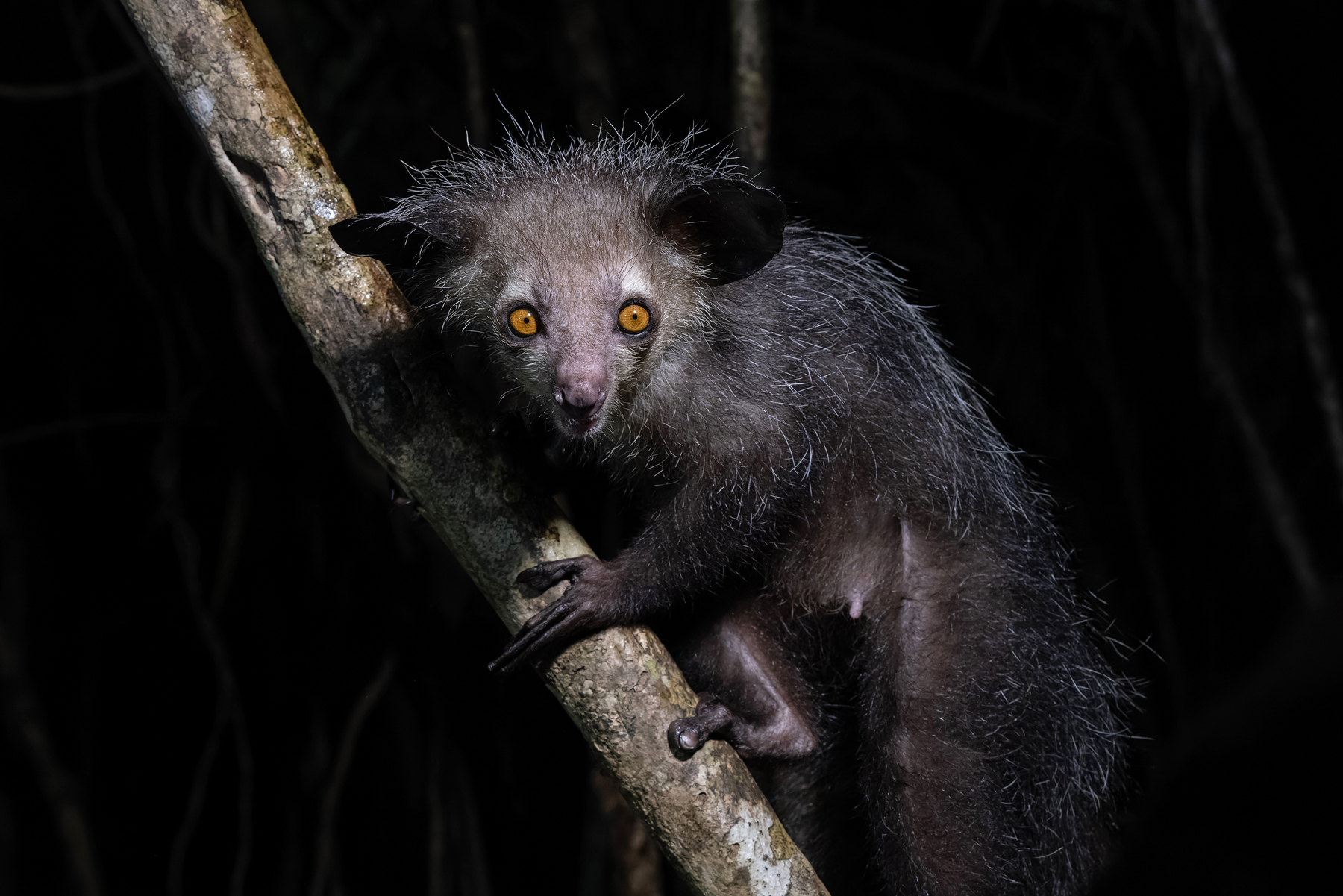
Touching distance views of Aye-aye was a tour highlight for most (image by Mike Watson)

Strabena-triopthalma, another pretty little Madagascan satyr without an English name (image by Mike Watson)

Fony Baobabs are basically huge water bottles (image by Mike Watson)

This gorgeous female Fosa lit up our time at Kirindy Forest (image by Mike Watson)

Red-shouldered Vanga in the bushlands of La Table south of Toliara. One of Madagascar’s most sought-after endemic birds (image by Mike Watson)

A buttressed forest giant in the primary forest at Mantadia National Park (image by Mike Watson)

Elephant-eared (or Short-horned) Chameleon (Calumna brevicorne) on a roadside night walk at Andasibe (image by Mike Watson)

A critically endangered Spider Tortoise in the spiny forests of the southwest (image by Mike Watson)

Wild Images group in action at Kirindy Forest (image by Mike Watson)

Ronnie having fun at Isalo Rock Lodge, there is time to relax on this tour! (image by Mike Watson)

A beautifully marked Standing’s Day Gecko, another southwest speciality, roadside at Zombitse (image by Mike Watson)

Narrow-striped Mongoose had gone back to its former difficult-to-photograph status at Kirindy Forest. It did not appear to be scavenging around the dump (image by Mike Watson)

The Aye-aye has perpetually growing front teeth, like a rodent! (image by Mike Watson)

This Malagasy Cat-eyed Snake was resting in the fork of some palm fronds (image by Mike Watson)

A pair of Collared Nightjars roosting side-by-side at Parc Villagois V.O.I.M.M.A., Andasibe (image by Mike Watson)

A Barn Owl emerges from the gloom at Perinet (image by Mike Watson)

Our awesome Malagasy guide Fabrice could fix everything for us (image by Mike Watson)

Verreaux’s Sifaka family at Kirindy Forest (image by Mike Watson)

Dumeril’s Ground Boa incoming! (image by Mike Watson)

The long tail of a Spectacled Tetraka sticks out of its nest at Mantadia National Park (image by Mike Watson)

Malagasy Mother of Pearl butterfly under the canopy of the primary forest in Mantadia National Park (image by Mike Watson)

Big-eyed Snake at Isalo National Park (image by Mike Watson)

Goodman’s is the Mouse Lemur on night walks at Andasibe (image by Mike Watson)
Many of us had been waiting a long time to make the journey to the ‘Eighth Continent’, so it was a great relief to finally set foot in Antananarivo’s shiny new international airport terminal and embark on another odyssey of Malagasy wildlife. We revisited favourite destinations: Kirindy Forest in the west; the Spiny Forest of the far southwest; the shady sandstone canyons of Isalo National Park and the eastern rainforests of Andasibe. However, this time we decided not to venture north at the end of the tour, but instead to visit Le Palmarium, on the east coast, for an audience with the Aye-aye. As a one-off visit to Madasgascar we think our present itinerary offers a great sample of its natural treasures, with a wide range of orders as well as cherry-picking some of its most iconic animals. Travel in Madagascar is not without its challenges, road journeys are often long and on bumpy roads but the wildlife-packed national parks waiting for you at the end of them make the effort worthwhile!
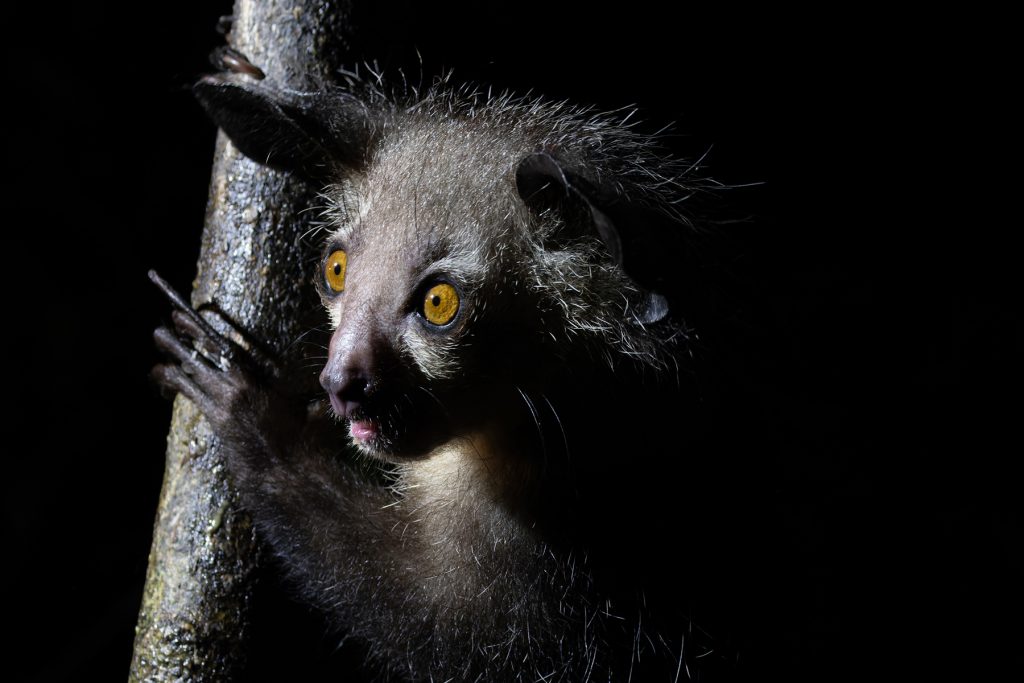
Aye-aye eyes a blaze, one of the weirdest mammals on the planet (image by Mike Watson)
We usually visit the far southwest first on our itinerary, but flight timetables dictated that we had to reorder our stays and start with Kirindy Forest this time. Highlights here were: Fosa, Madagascar’s largest carnivore; closely followed by some lovely time spent with Verreaux’s Sifakas; Narrow-striped Mongoose deep inside the dry deciduous forest; the most gorgeous Grey Mouse Lemur encounter during daytime and great looks at both White-browed and Torotoroka Scops Owls, also in sunlight. A couple of very good Oustalet’s Chameleons filled our memory cards and both Pale Fork-marked and Red-tailed Sportive Lemurs dazzled at night. We also enjoyed the trees themselves, particularly the majestic Grandidier’s Baobabs scattered around the forest but especially at the Allée du Baobabs, another classic ‘bucket list’ experience.
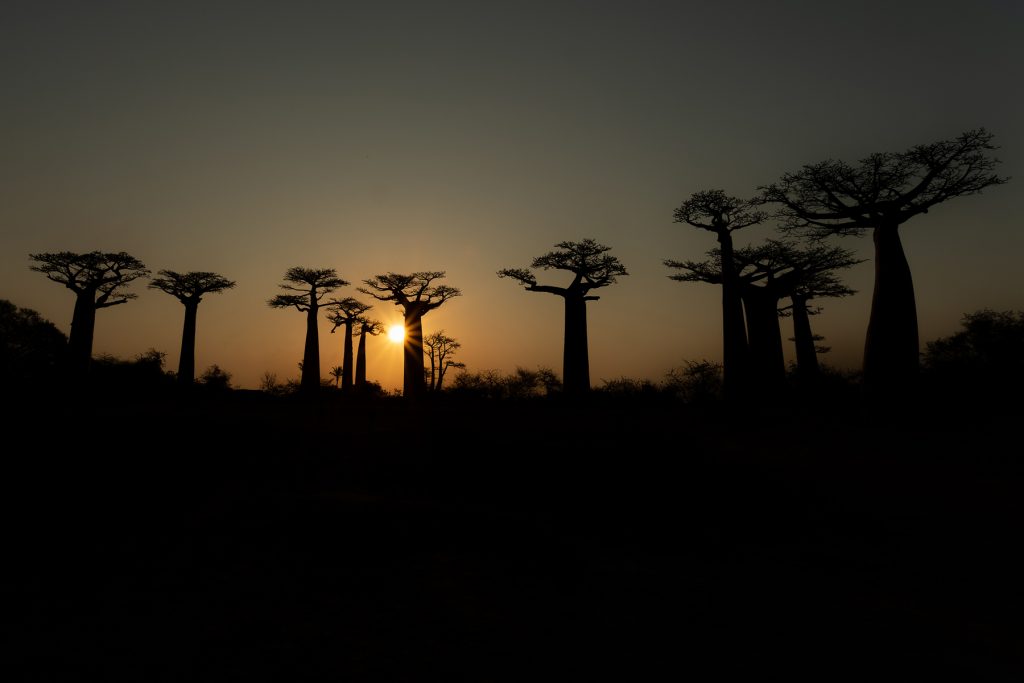
The sun sets behind the iconic Allée du Baobabs near Morondava on Madagascar’s west coast (image by Mike Watson)
Using Antananairvo (or simply ‘Tana’) as a hub we headed southwest to Toliara, from where we explored the incomparable Spiny Forest near Ifaty, one of the most unique ecosystems in the world. The stars of the show were the bottle-shaped Fony Baobab trees but the flagship animal species of the Spiny Forest is Long-tailed Ground Roller and again, thanks to our awesome local guides, we had another perfect view of this lovely bird. When I planned this tour some years ago, they said this would be a difficult one for a group to photograph but we are now three from three, so there you go! We also had two excellent looks at Dumeril’s Ground Boa, the apex predator of the Spiny Forest, what a privilege to see not one but two of these awesome snakes! There were plenty of other great photo opportunities in the spiny forest. Day walks yielded Subdesert Mesite, Madagascar Nightjar, Running Coua and the critically endangered Spider Tortoise, and night walks produced Lesser Hedgehog Tenrec, White-footed (probably) Sportive Lemur, Hissing Cockroach and Standing’s Day Gecko among others. Each major destination contributed a chameleon and in the Spiny Forest it was the truly prehistoric-looking Antimena Chameleon. The food at Ifaty was probably the best of the tour, thanks to a jaw-dropping seafood platter at Chef Freddy’s!
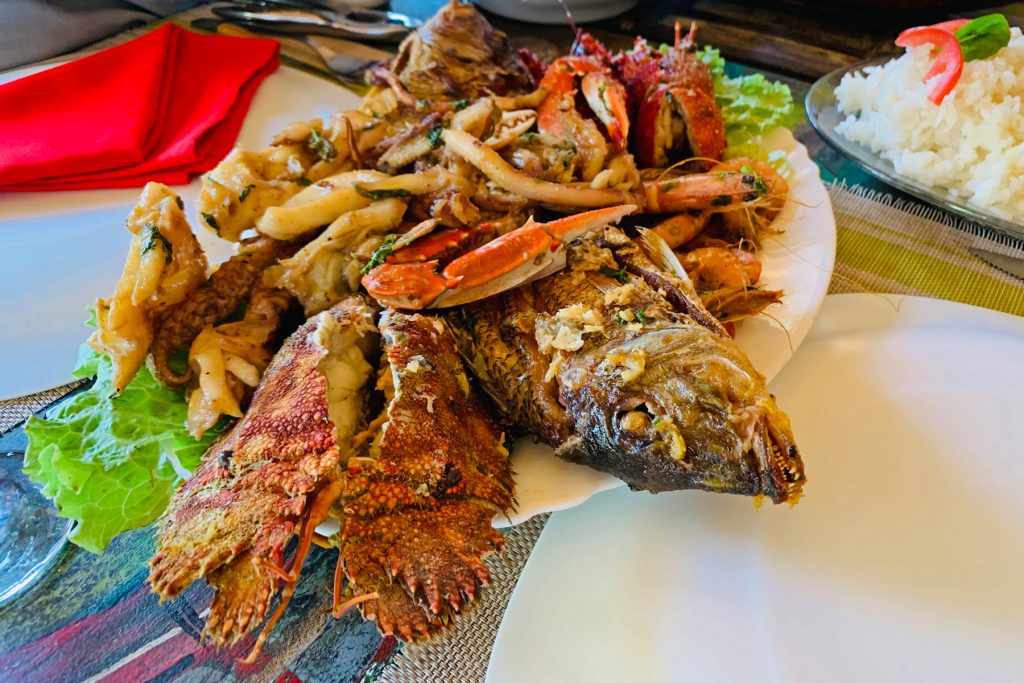
Now that’s what I can a seafood platter! Ifaty (image by Mike Watson)
From Ifaty we drove inland to the sandstone country of the interior. Fortunately, recent wildfires had not affected the sites we visit at Zombitse or Isalo National Park, but we could see smoke in the distance and charred landscapes here and there. Zombitse was stinking hot and glary so not ideal photographically, but we did see some interesting animals including Giant Coua, Zombitse Sportive Lemur and Cuckoo Roller. However, Isalo’s Ring-tailed Lemurs were better than ever, and we saw some great macro critters too including the bizarre Net-casting Spider. It was great to see that the best accommodation on the tour was still going strong and what a lovely sundowner we had there, in stunning surroundings, a real highlight.
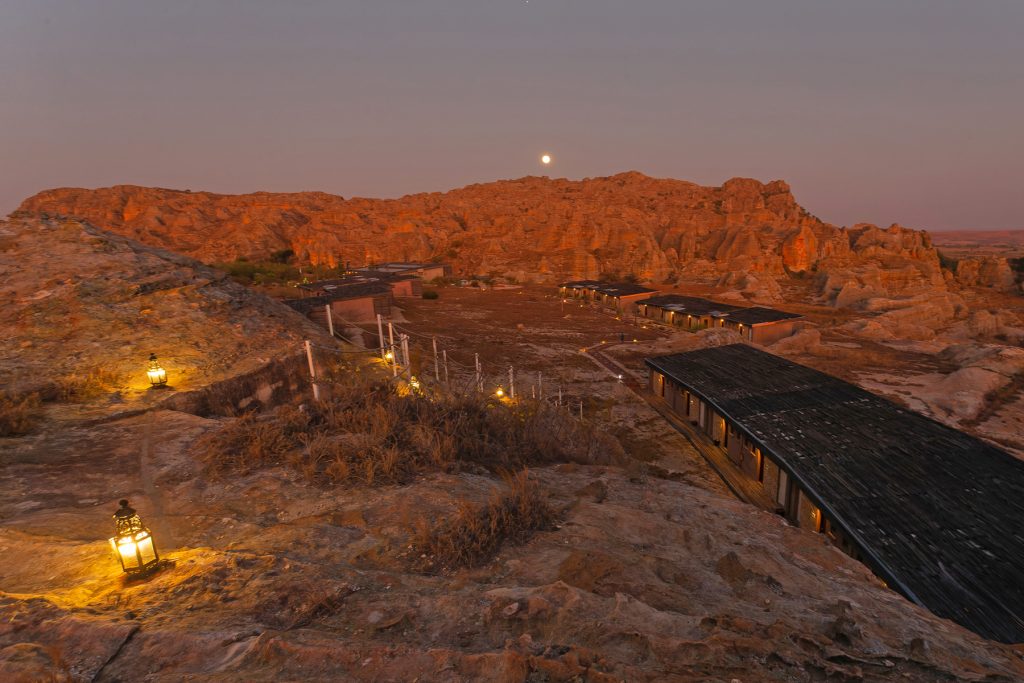
Darkness falls at Isalo Rock Lodge (image by Mike Watson)
All too soon it was time to head back to Tana and make our way to the eastern rainforests of Andasibe. We had two full days, one of which we spent in the primary forest of Mantadia National Park, where the critically endangered Black-and-white Ruffed Lemur was the highlight. We also got some close views of that understorey denizen Scaly Ground Roller. Our other full day, in the secondary forest of Analamazoatra National Park, resulted in some nice views of the incomparable Indri, the largest (and nosiest) extant lemur as well as the gentle Diademed Sifaka, thought by many to be the most beautiful lemur of all. Our amazing local guides showed us a pair of ultra-cryptic Collared Nightjars at their day roost, another benchmark wildlife experience for this tour. They also showed us the world’s heaviest chameleon, Parson’s, both by day and night, the range-restricted Elephant-eared Chameleon and, to our delight, both Mossy and Satanic Leaf-tailed Geckos.
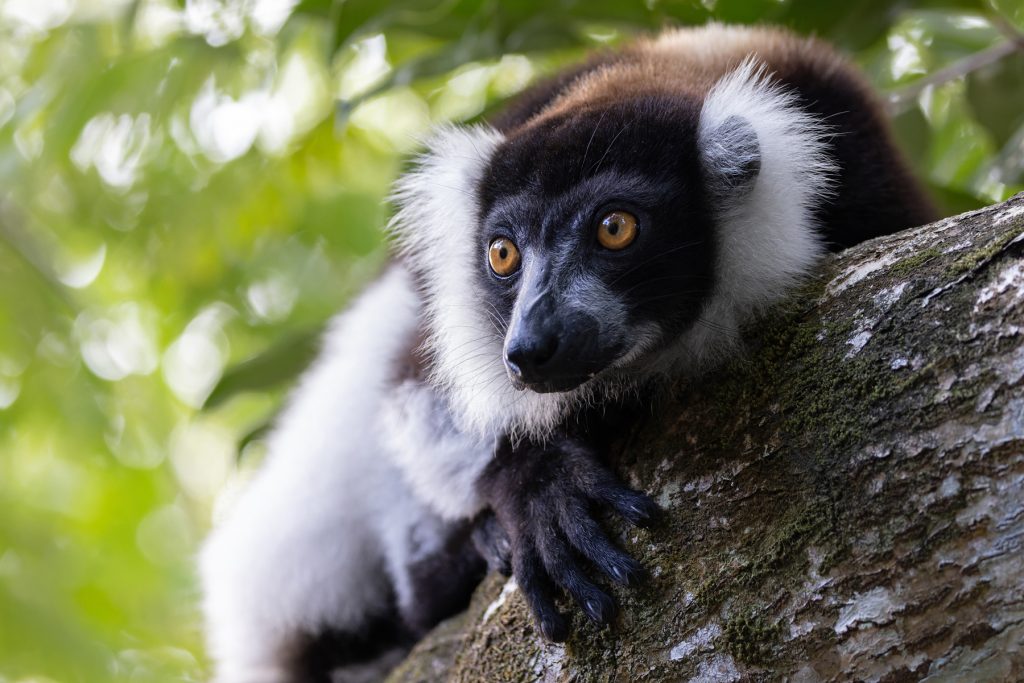
Easily the boldest lemurs around the lodge the blood-curdling screams of Black-and-white Ruffed Lemurs can be heard at night too (image by Mike Watson)
Le Palmarium, on the east coast, was a very fitting grand finale to our tour with the Aye-ayes well exceeding our expectations and putting on a terrific show for the cameras at point blank range in a lovely setting. An assortment of transplanted lemurs offered some great portrait opportunities and there were some very nice macro critters in the form of Panther Chameleon (near the southernmost limit of its range here), a couple more snakes and frogs as well as another chance to photograph the massive Parson’s Chameleon.
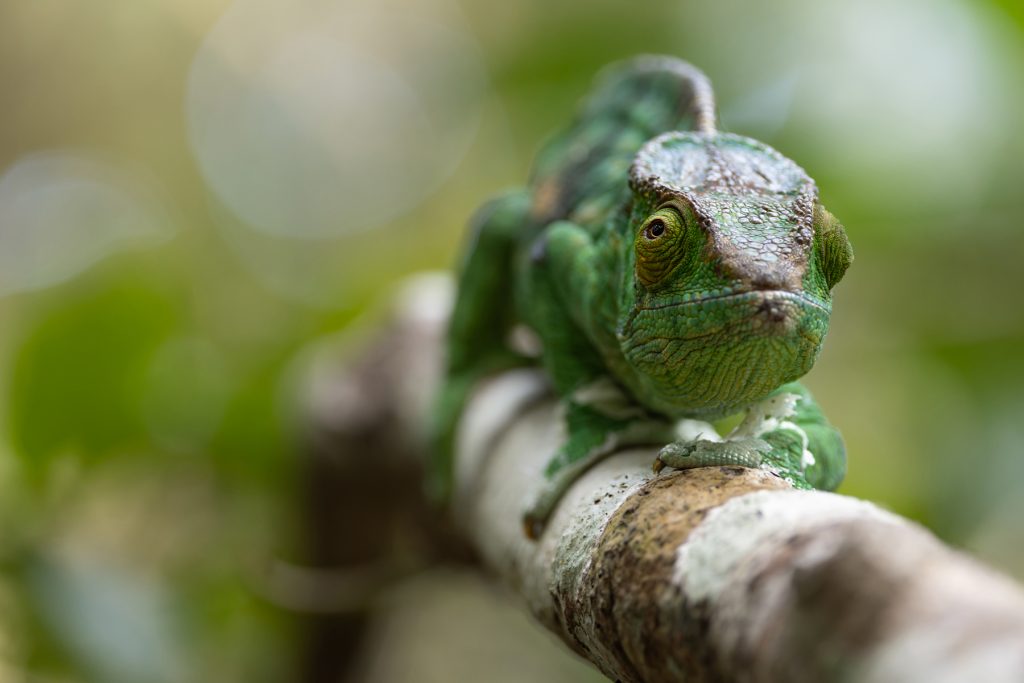
Parson’s Chameleon, Le Palmarium. This one had been sloughing its skin (image by Mike Watson)
Although many hours were spent on the road, it was a joy that all our flights operated on the correct day (this must be regarded as a bonus, not an expectation) and we did not experience any other significant problems. We met some awesome Malagasy people and had a lot of laughs from the east to the west on this tour. When running through plans with our Mr Madagascar, Fabrice, who would be our fixer and escort throughout the tour, he told me ‘There are no Fosas at Kirindy, I haven’t seen one in three visits since the lockdowns’. This was a crushing blow, with Fosa being our most important target in the west. As you already know, we did ultimately see Fosa but to say I was worried for a while is an understatement. I sat next to another tour escort on the flight to Morondava and she had missed Fosa the last two times she was at Kirindy too! A good fixer is an essential role in a country where few people speak French and very much fewer English, and liason with the many local guides we use makes the difference between a successful tour, or otherwise. Fabrice spent many hours of hard work ensuring that things were recce’d and set up in advance of our flying visits and they mostly worked very smoothly indeed!
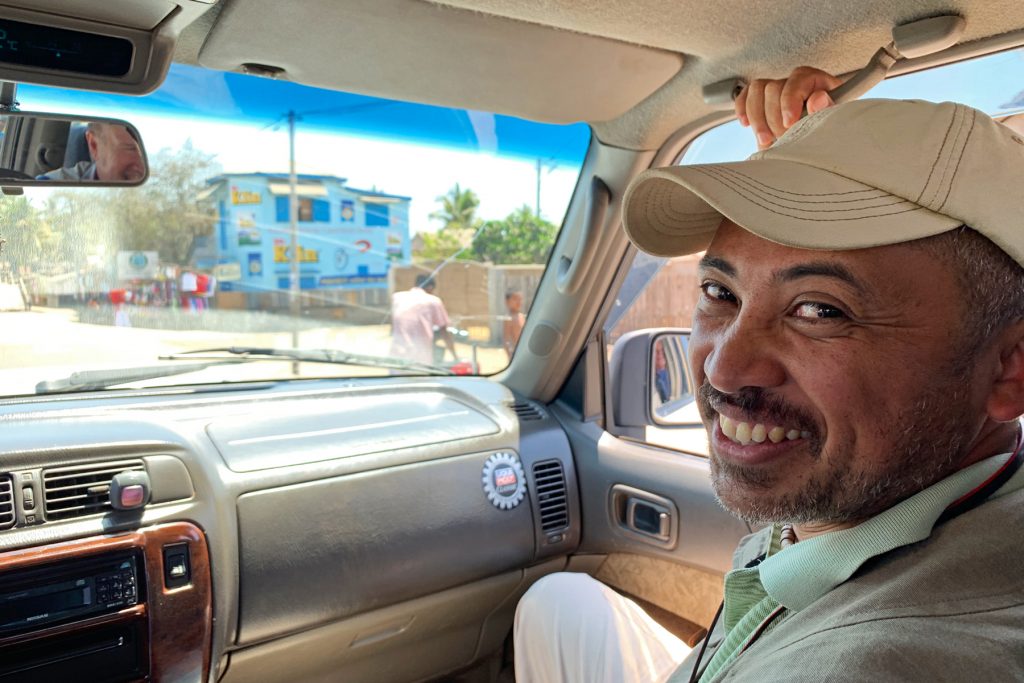
Our awesome Malagasy guide Fabrice could fix everything for us (image by Mike Watson)
There were a few interesting birds in the garden of our hotel in Tana’s suburbs – Madagascar Wagtail, Bulbul, White-eye and after dark, Nightjar, churring away from the rooftops. After breakfast we departed for the airport to catch the Tsaradia Airlines (= the rebranded Air Madagascar) flight to Morondava. The first of four aboard their gaudily wrapped French-built ATR propellor-engined aircraft. Morondava has a tiny little airport terminal and we were soon greeted by our reliable team of drivers. In the heat of midday we drove through town to the beach to have lunch at one of our favorite spots, Bleu Soleil. Sea food is a speciality! Fab-u-lous prawns! A cool breeze from the Mozambique Channel carried the calls of the whimbrels from the beach, they were occasionally moved on by the many kids playing there. After lunch we drove north along a bumpy track, passing rice paddies, slashed and burnt, overgrazed pasture and through the dusty Allée du Baobabs on our way. After a couple of hours we reached Kirindy Forest, it was good to see that the edges of the forest looked pretty intact. I had wondered what state it might have been in following the lockdowns, particularly after hearing that there weren’t any Fosas around.
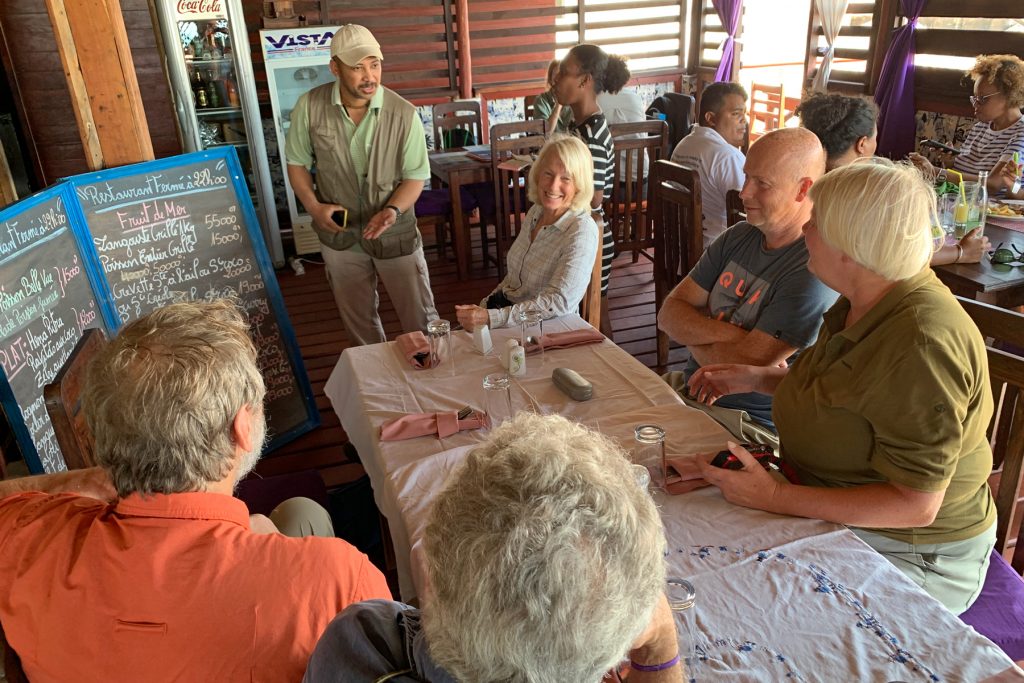
Menu explanation time in Morondava (there is always awesome seafood on the west coast!) (image by Mike Watson)
So, we dropped bags at our lodge and continued north a few kilometres to the Forest Station entrance track. Bumpier than ever, driving down this track to one the world’s most famous wildlife locations is always exciting and the instant we rolled up in the car park one of the other guides signalled that a Fosa was on view. Action stations! It’s on! We raced to the edge of the chalets and there she was, the most beautiful creature just standing and looking at her admirers from a low sandy bank. BAM! Within one minute of arriving (as it later turned out) my best images were on the card. She wandered around the edge of the forest station for a while but didn’t pose so nicely again as the late afternoon light faded. A rather brief encounter compared to so many of those or previous years but we were very happy to take it. A white-backed white morph Madagascar Paradise Flycatcher darted between the chalets, trailing its unfeasibly long tail as we started to look forward to our first night walk. Other birds seen this afternoon included Madagascar Turtle Dove, Crested and Giant Couas and Madagascar Fork-tailed Drongo. Sharp-eyed Angela spotted a couple of Narrow-striped Mongeese darting across the main track. None of these were photographable though.
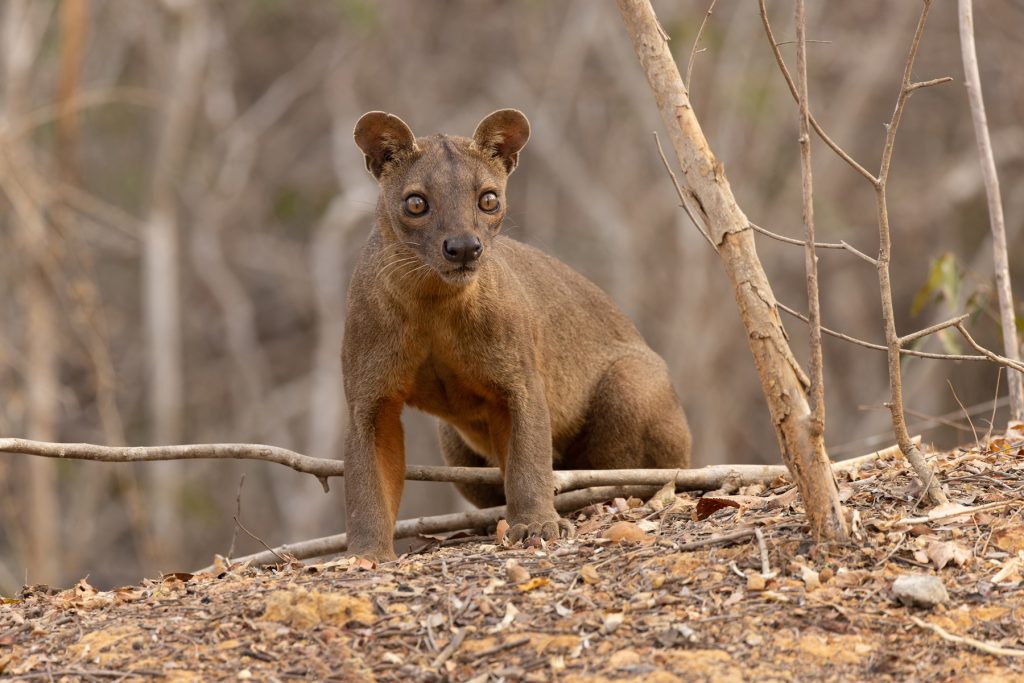
This gorgeous female Fosa lit up our time at Kirindy Forest (image by Mike Watson)
Almost all night walks take place on the grid at Kirindy, a network of maintained trails that usually produces a good variety of wildlife. On our first walk we managed Grey Mouse Lemur, Red-tailed Sportive Lemur and Pale Fork-marked Lemur. Nice to look at but precisely none of them were photogenic this time in very humid and sweaty conditions. A Big-headed Gecko (Paroedura pictus) was probably the best sighting. We also bumped into our dear friend Jean Baptiste, guiding the US Ambassador and her party, also on a night walk. This is obviously the place to be!
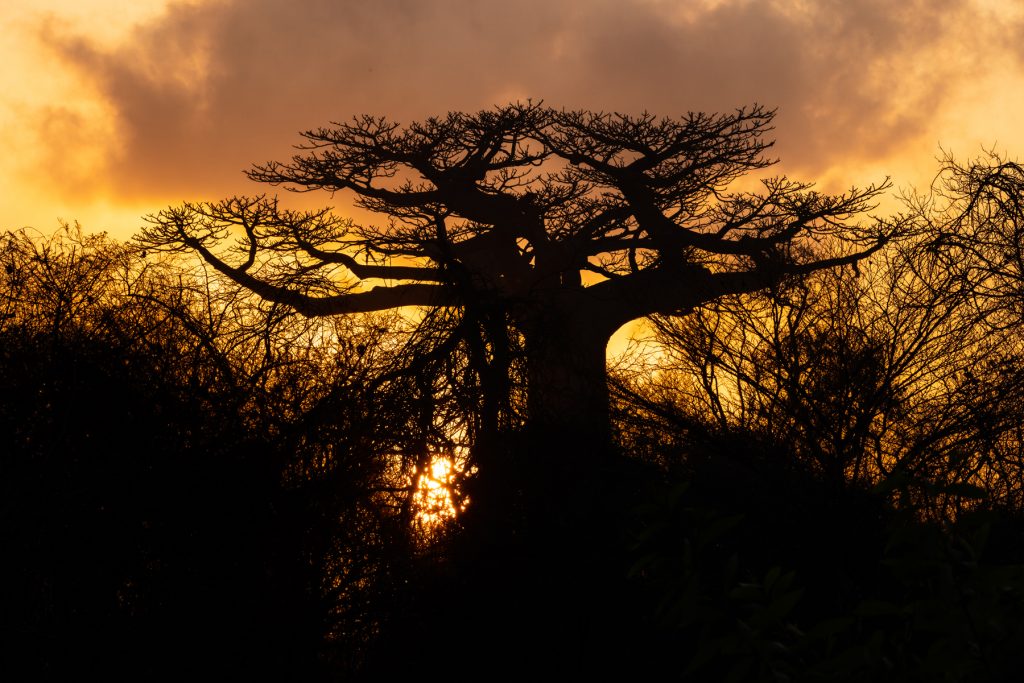
Grandidier’s Baobab sunrise at Kirindy (image by Mike Watson)
Our first full day at Kirindy started after breakfast, back on the grid, where we got to grips with more of the fabulous inhabitants of the forest. Top of the opps today was the family of Red-fronted Brown Lemurs that we watched at point blank range. Some of them were keen to drink water from the land snail shells scattered over the forest floor. Other good opportunities included a showy Oustalet’s Chameleon, which maintained a rich rufous colour while we were able to photograph it at close range. A Red-tailed Sportive Lemur was sitting at the entrance to its daytime roosting hole, as ever ready for a sharp exit in the event of real danger, rather than curious photographers! A pair of White-breasted Mesites delighted on the forest floor, bizarre sandgrouse relatives, although there is not much similarity in appearance and a very nice Collared Iguanid (Oplurus cuivieri) – a strikingly-marked lizard, showed for some near the restaurant. We were joined by Jean Baptiste this afternoon. The gorgeous white-backed white morph Madagascar Paradise Flycatcher gave itself up to the cameras nicely and a Torotoroka Scops Owl at its roost hole was another decent photo subject.
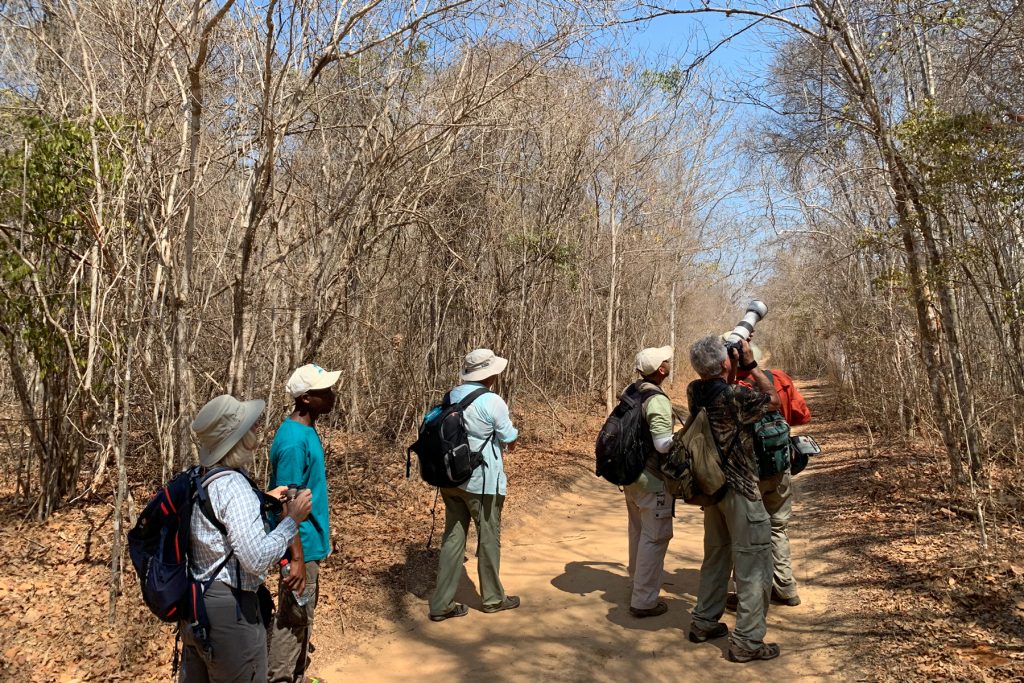
Wild Images group in action at Kirindy Forest (image by Mike Watson)
Suboptimal encounters included birds such as Rufous Vanga, Lesser Vasa Parrot, Crested Coua and Common Jery. Out of reach of the cameras were Madagsacar Buzzard, Souimanga Sunbird and the ever-elusive Narrow-striped Mongoose, again. We also had our first sighting of Verreaux’s Sifaka around the forest headquarters, where a family party of seven moved slowly through the area, some feeding precariously on tree fruits high up in the outermost branches! We also saw the female Fosa again but she was even less co-operative than the previous day, mostly moving quickly through the forest beyond the perimeter of the station buildings and always obscured by the understorey twigs and branches. We did another night walk on the grid but only scored exactly the same three lemurs as the previous night. A second night walk, an attempt at Giant Jumping Rat after evening meal failed, probably as we were too tired to stay out late enough by its burrow (until after midnight, when they tend to be more active), although the night soundscape of the forest was wonderful. The calls of Torotoroka Scops and White-browed Owls and Madagascar Nightjar echoing in the darkness.
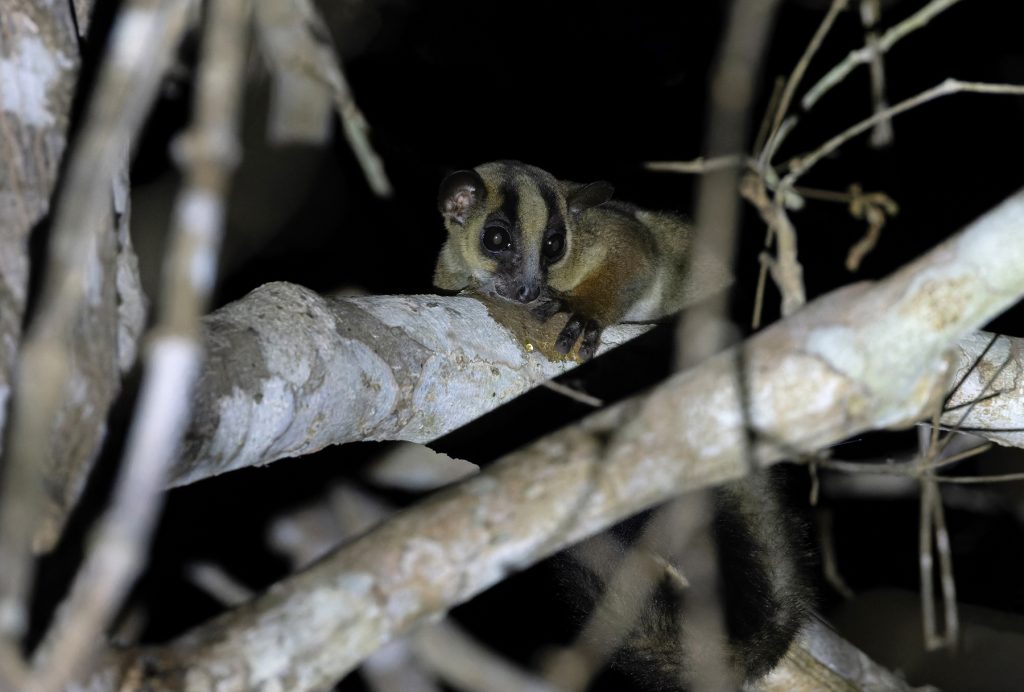
Pale Fork-marked Lemur on a night walk in Kirindy Forest (image by Mike Watson)
Getting into the vehicles outside our lodge reception we were distracted by a great Olive Bee-eater, catching large black flies and returning to the same perch each time. Back into the forest, we switched our focus to another site, where there is an excellent lemur feeding station. Lemurs are attracted during the dry season to the red jujube berries and water put out for them. Our main focus was the family of lovely Verreaux’s Sifakas, which arrived on cue, and spent a considerable time around the small clearing feeding station where we managed some great looks at them. However, they do not always stay still, walk across a suitable background at a desirable angle or in the right light so some of us were left wanting a second try. More of that later. Eventually a troop of more aggressive Red-fronted Brown Lemurs appeared on the scene and the sifakas melted away into the forest.
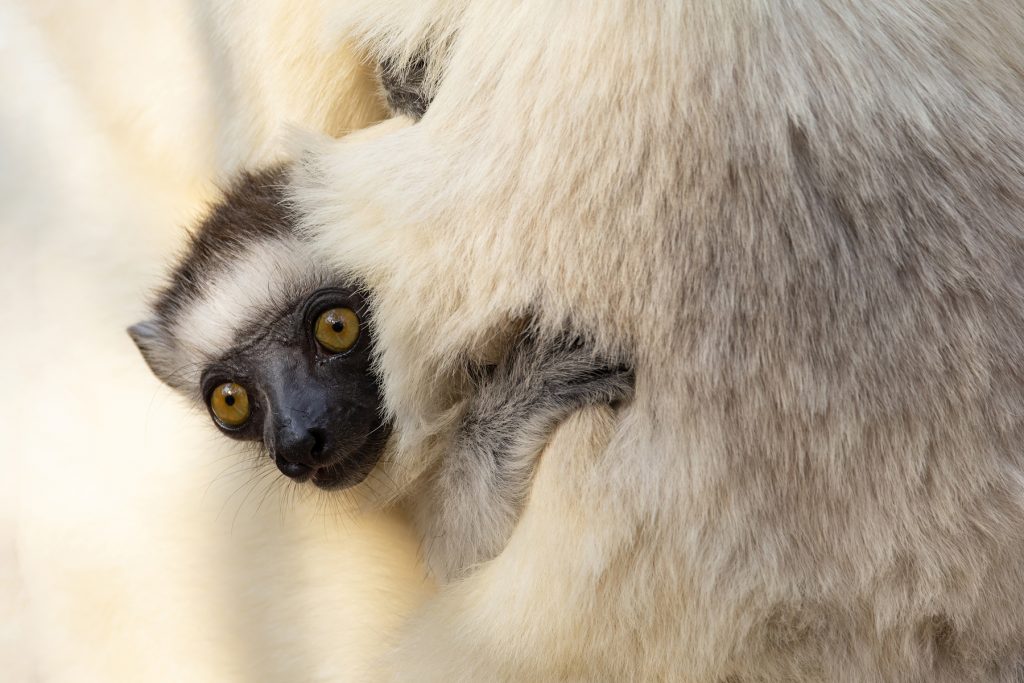
Verreaux’s Sifaka baby riding on mum at Kirindy Forest (image by Mike Watson)
We explored the forest itself more widely and managed some pretty good images of White-browed Owl, relatively unobscured for once! Grey-headed Lovebirds were also quite worthwhile and we spent some time looking at trees including important species such as Fony Baobabs, Ebony, Pallisandre and Euphorbias. The thermometer almost reached 40 degrees Celsius in the heat of the today, way hotter than we have experienced here before and it was pretty hard going at times. The forest here is crammed full of natural treasures. Probably our best photos today were of an exquisite Grey Mouse Lemur at the entrance to its day roosting hole. It seemed quite unconcerned at our presence! The amount of rufous around its eyes had us thinking about the even more diminutive Madame Berthe’s Mouse Lemur, however, the ginger spectacles were limited to the area around the eyes and did not extend to the ears as in the latter and also the ears themselves were too large for it to be the world’s smallest primate. These features are not well illustrated in field guides at the moment, but they are quite clear in photos of both species. Worringly, I heard later that the guides had not seen MBML for months at Kirindy. In the past we had even seen them behind the main forest station buildings there.
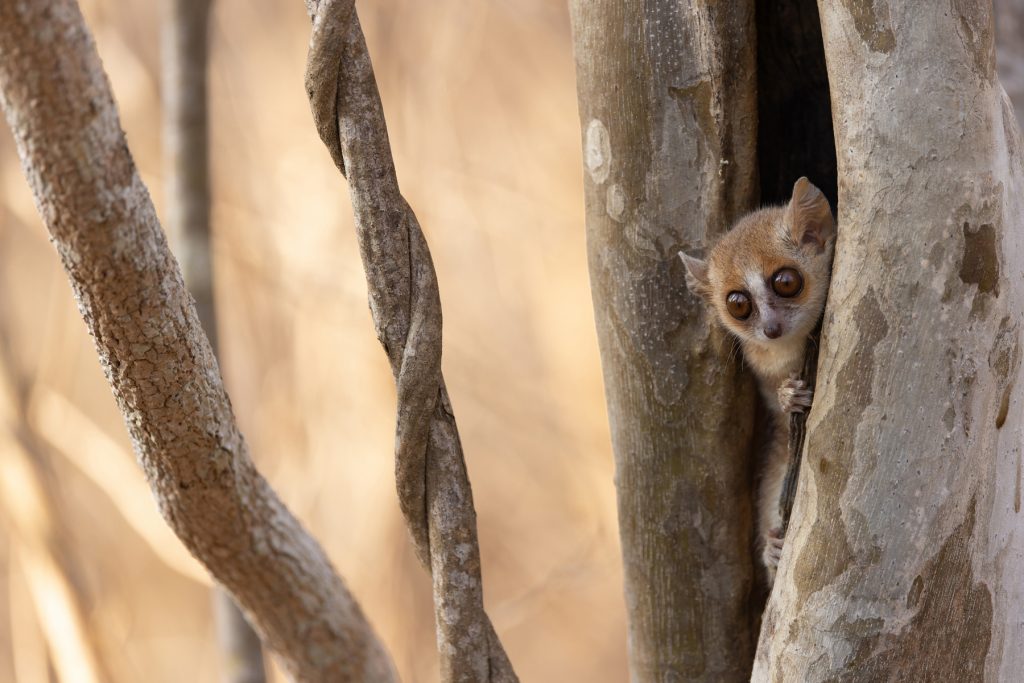
A tiny Grey Mouse Lemur peers from its daytime roosting hole at Kirindy (image by Mike Watson)
The afternoon session also produced another great chameleon encounter, with a very grey Oustalet’s Chameleon and initially this one was called as a Warty. However, the photos show too many spines along its dorsal crest, consequently with no clear daylight between them, as in its close and vey similar relative, Warty, which has less than 40 spines. The dorsal crest of Oustalet’s looks more like a zipper to me than a line of well defined large spines. Warty looks something like half way between Oustalet’s and the ridiculously large and prominent spines of Antimena Chameleon. We watched the sun go down over a coffee and did yet another night walk in the forest here scoring the same three lemurs again but this time Pale Fork-marked was a little closer and co-operative for our photographers.
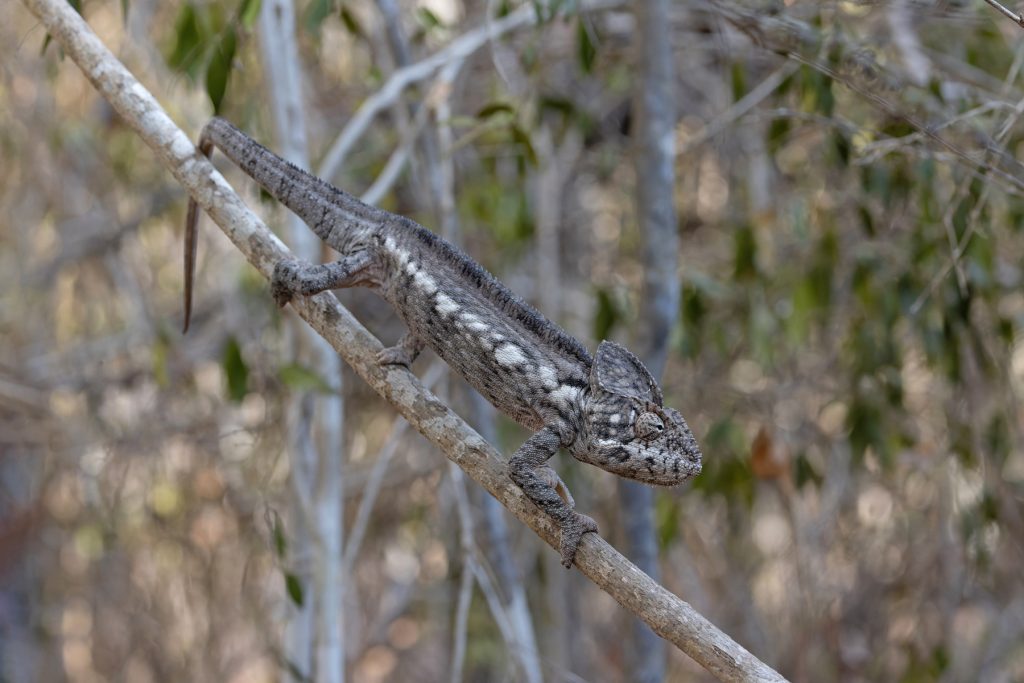
Oustalet’s Chameleon at Kirindy Forest. The grey presenting ones sometimes get called as Spiny | Warty Chameleons but there’s no daylight between the dorsal spines on this (image by Mike Watson)
Our third full day in Kirindy Forest was spent back on the grid with Jean Baptiste. The morning session was great in a little cooler temperatures. First of all, we found a Hook-billed Vanga nesting in the fork of a baobab. Next came a fabulous encounter with a couple of Narrow-striped Mongeese, in the vicinity of a falled tree. They showed a few times in unobscured positions but were generally quite challenging, even more so when another group of vahaza (tourists) added to our numbers and they cleared off completely. A Tototoroka Scops Owl showed ridiculously well by its roosting hole, even allowing JB to move a small vine, which was ruffling its wing feathers. I have never seen anything like this before! Other birds in the forest affording photo opportunities this morning included Long-billed Tetraka, Common Newtonia, Sakalava Weaver and an unco-operative Giant Coua.
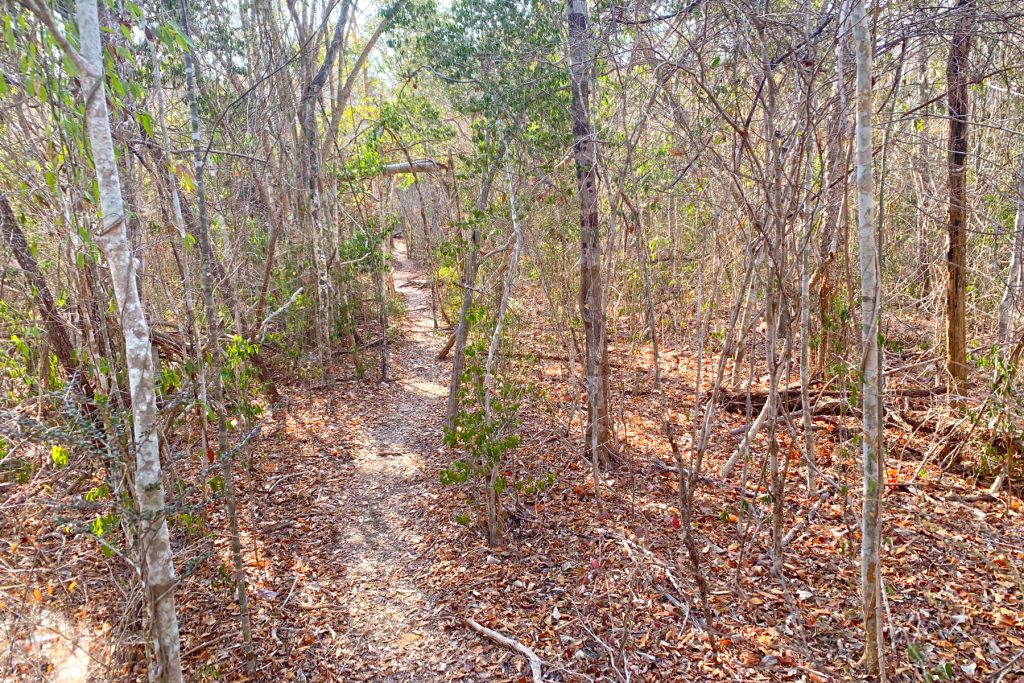
The baking hot sunlit trails of the grid at Kirindy Forest were hard work this year (image by Mike Watson)
The afternoon session added some more birds to our photo lists – White-headed and Chabert’s Vangas, Crested Coua and an immature Harrier Hawk – which is more like an eagle than either a harrier or a hawk. On the mammal front we had some more brief looks at the female Fosa, the Verreaux’s Sifaka family and Red-fronted Brown Lemur. Before evening meal we tried a sunset session at a grove of baobabs out on the slashed and burnt plain behind our lodge but were besieged by at least one million children from the village and the sunset itself was less than spectacular, with a bank of cloud on the western horizon. A final night vigil for Giant Jumping Rat again resulted in failure but at least we enjoyed another nocturnal chorus of owls and nightjars. A Grey Mouse Lemur eating a vine vanilla pod was another first for me.
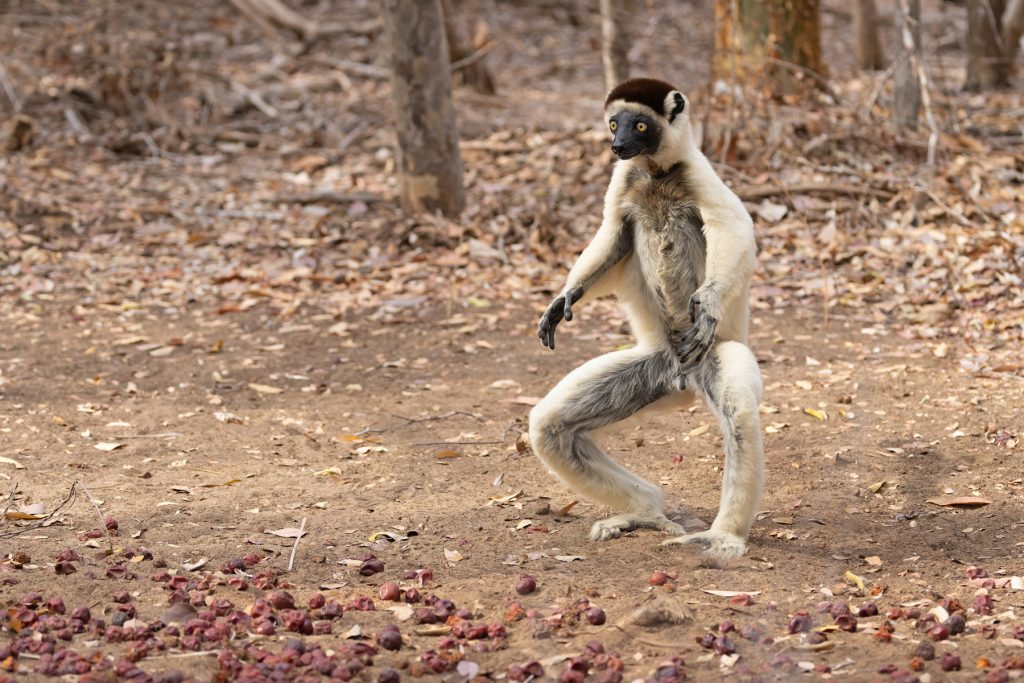
Dancing Verreaux’s Sifaka at Kirindy (image by Mike Watson)
Our time at Kirindy Forest was drawing to a close and a final morning session was spent back at the lemur feeding area. This was a brilliant session as everyone had figured out where they wanted to position themselves. The sun was nicely filtered by cloud and the Verreaux’s Sifakas looked stunning! Especially the mums carrying babies. Sure enough the Red-fronted Brown Lemurs turned up again and saw off the sifakas, however, photographically they are very much the poor relations.
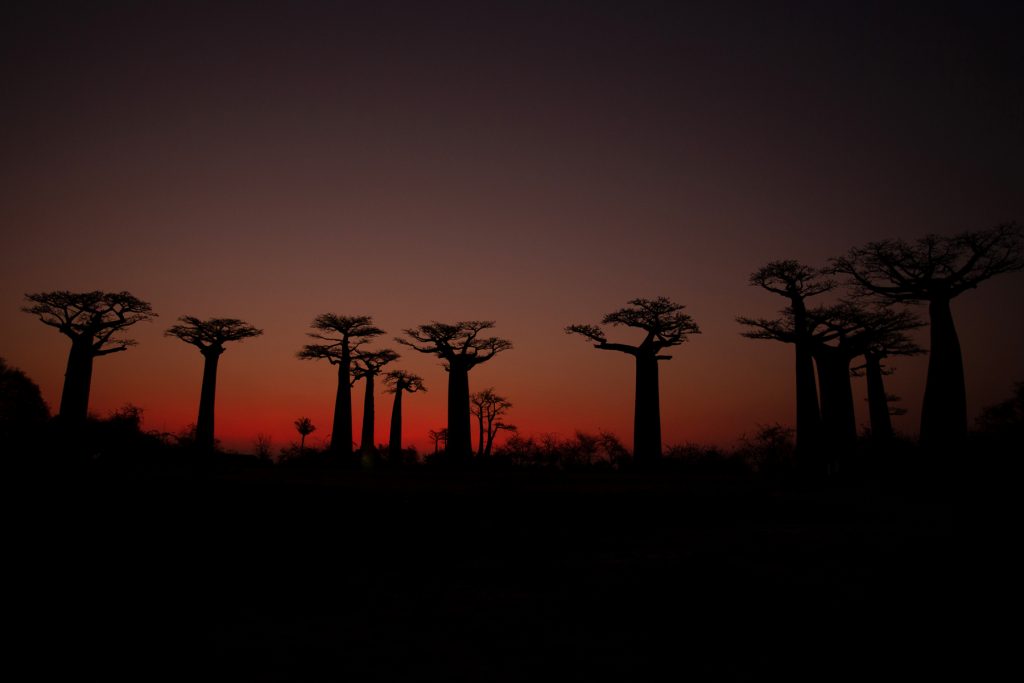
Around 20 minutes after sunset, when the crowds have hurried back to the hotels, a red orange glow appears (image by Mike Watson)
Driving south, we passed by the Baobabs Amoreux in less than satisfactory afternoon light so we continued on to spend the rest of the afternoon at the Allée du Baobabs. This was a mixed session. The popularity of this site has now grown to such that photos of the avenue itself are impossible without at least one million incongruous vahaza in the frame, until the sun starts to dip below the trees and we can underexpose everyone else in the foreground out of our images, and clone out those holding up bright Iphone screens to take the scene in front of us. The results can still be worthwhile and we also waited until around 20 minutes after sunset when the red glow appeared on the western horizon for a different effect. The final leg of our journey took us into town and to our gorgeous hotel, with the sound of waves on the shore and nightjar singing from the trees along the beach as we walked through the deep sand to our stunning chalets. Another place where it would be lovely to spend a few days doing exactly nothing.
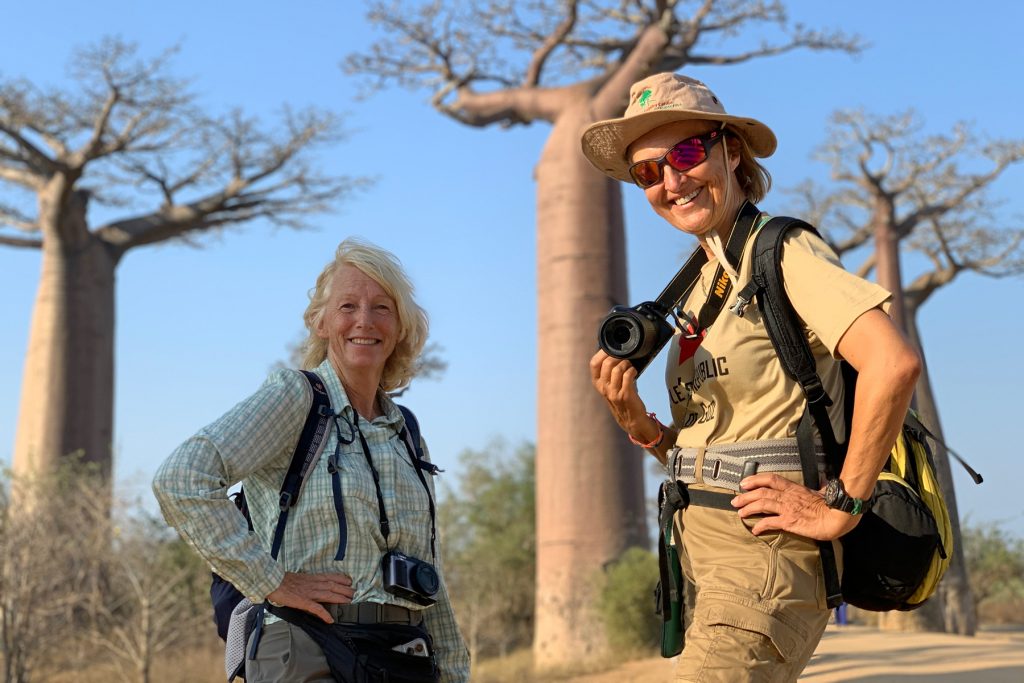
Wild Images ladies at the Allée du Baobabs (image by Mike Watson)
The next stage of our tour was the far southwest of Madagascar but to do this we used Tana as an airport hub. There are few flights between destinations and those offered occasionally are frequently changed or cancelled. So back to Tana then. Our flight from Morondava passed without incident but we soon learned that our onward flight to Toliara in the southwest had been rescheduled for later in the afternoon. What to do then? Rather than sit around in the airport, our guide Fabrice arranged a coach trip to a lake in the city centre that we have visited many times before, Lac Alarobia, which is a protected nature reserve in the grounds of some diplomatic residences. As usual it was absolutely rammed with waterbirds and among the abundant Red-billed Teal and White-faced Whistling Ducks we eventually picked out a handful of the rare Meller’s Duck. Unfortunately they were totally underwhelming photographically being too far away around the sanctuary of the reed island in the lake and in a horrible heat haze in the middle of the day. Record shots were possible though and we also picked out several Hottentot Teal among the throng of ducks. Herons and egrets were very well represented again with nine species and included two Madagascar Pond Herons, in their fluffed up breeding plumage, these too were also out of acceptable camera range. A large Humblot’s Heron waded in the shallows around the island and several Malagasy Malachite Kingfishers zipped around the edges of the lake. Well it was better than sitting in the airport terminal. We called in for a very tasty pizza at one of our favourite eateries and then it was back to the airport where the flight to Toliara eventually departed.
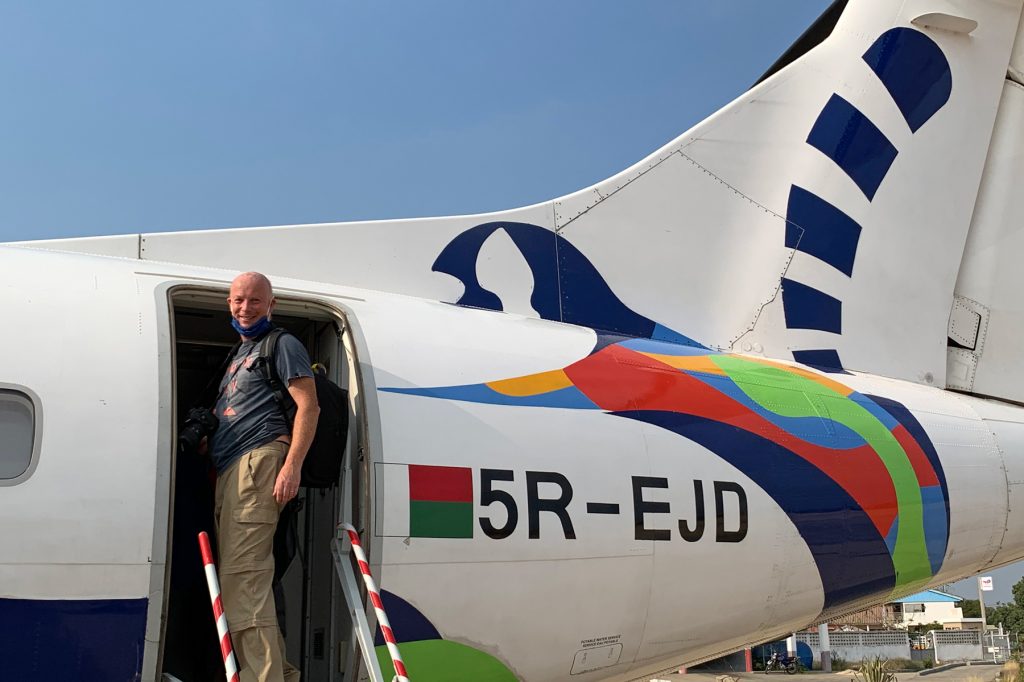
Air Mad has been rebranded as Tsaradia! We like it! (image by Mike Watson)
Flying south over the hinterland of the island it is soon obvious just how dry and eroded the landscape is. The south has been experiencing a drought lately and even the main river at Toliara has run completely dry. Toliara has a growing population of around 170,000 and its main income comes from the production on sisal, hemp, cotton, rice, peanuts and soap. Again there were hardly any elderly folk around, not surprising when over 40% of Madagascar’s population is under the age of 15. Life expectancy for men is in the early sixties! Toliara is also only a stone’s throw north of the Tropic of Capricorn, which crosses the southern tip of Madagascar but we never venture quite that far enough south (23.4394 degrees). Fortunately the reserves we hoped to visit were still intact following the lockdowns and our awesome local guides had all survived these too. A very warm welcome awaited us! We dropped some of our party off at our next resort and the rest of us headed straight out to one of the spiny forest reserves for a night walk. A Madagascar Kestrel and Black-winged Stilt were seen on the way to the forest but the roadside wetlands were painfully dry this time with only tiny algae-filled puddles remaining. We spread our net a bit wider this time, as well as spending a little more time in the Spiny Forest rather than nearby marginal habitats. This paid off. Night walks are always exciting in the early evening here and we quickly racked up some interesting sightings, starting with a large cricket and then an imposing tree hole spider. It was svery humid inside the forest and even though the temperature was not too high the sweat was soon pouring off us! Mammals followed with Grey-Brown Mouse Lemur, a (presumably) White-footed Sportive Lemur, the specific identity of Ifaty’s sportive lemurs has not yet been decided, high up in a didierea and the delightful Lesser Hedgehog Tenrec. A Common Big-eyed Snake (Mimophis mahfalensis) and a Standing’s Day Gecko were also seen. Photo opportunities were not quite up to scratch tonight though, sometimes the animals just do not arrange themselves among the zillions of twigs and branches! The now familiar Torotoroka Scops Owl and Madagascar Nightjar were also heard here. It was lovely to check in at one of my favourite places, especially seeing that our old friends were still here. A Madagascar Nightjar was hawking in the dunes between the dining area and my chalet as the waves could be heard breaking on the beach.
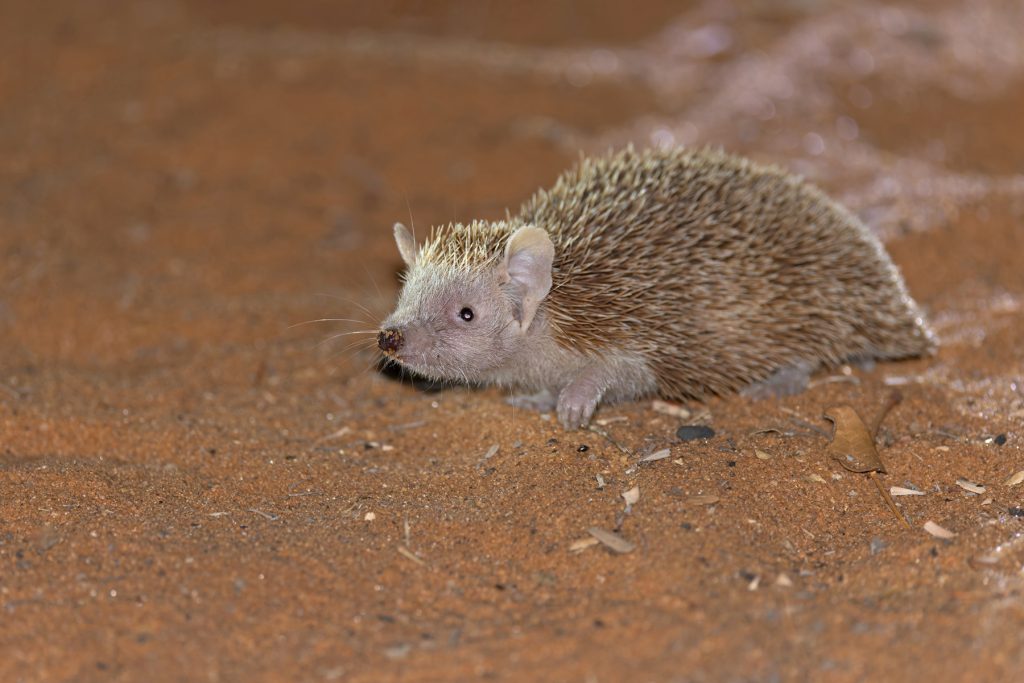
Lesser Hedgehog Tenrec in the spiny forest at Ifaty. I’ll say it again, can you believe this is not even a close relative of hedgehogs but is instead a product of convergent evolution? (image by Mike Watson)
We have one full day in the spiny forest and split this between two of the reserves, with an early morning excursion, an afternoon walk and a night walk. The morning walk followed the same routine as on our previous visits, with our awesome local guides first showing a roosting family of Subdesert Mesites (endemic to the spiny forest of southwest Madagascar), only three this time – are their numbers getting fewer? They remained in situ long enough for the sun to rise a little more and lighten their shadows better. Then came the iconic bird of the spiny forest, Long-tailed Ground Roller, another of my favourites! Sporting tourquoise wings and tail feathers and dusted with the red sandstone soil it had been digging in. Eventually we all enjoyed stunning views as it froze in the open between bushes allowing many hundreds of photos to be taken! Fab-u-lous! My best experience with this special bird to date. Although time was quite limited after we had spent as long with the ground roller as we wanted, we could still photograph some special inhabitants of the spiny forest. A Madagascar Nightjar at its daytime roosting spot was the best I have seen so far, sitting in a very nice assortment of leaf litter and perfectly lit by the weak, early morning sun. Other Spiny Forest specials Running Coua and Madagascar Hoopoe followed and we also saw a few of the introduced Ring-tailed Lemurs. A Three-eyed Lizard was seen on one of the paths but our guides told us that small bird numbers had suffered lately owing to the ongoing drought. Oh, and there was the forest itself, which is probably the real star. The squat, bottle-shaped Fony Baobabs in particular, sat here and there among a sea of thorny didierea (or octopus) trees.
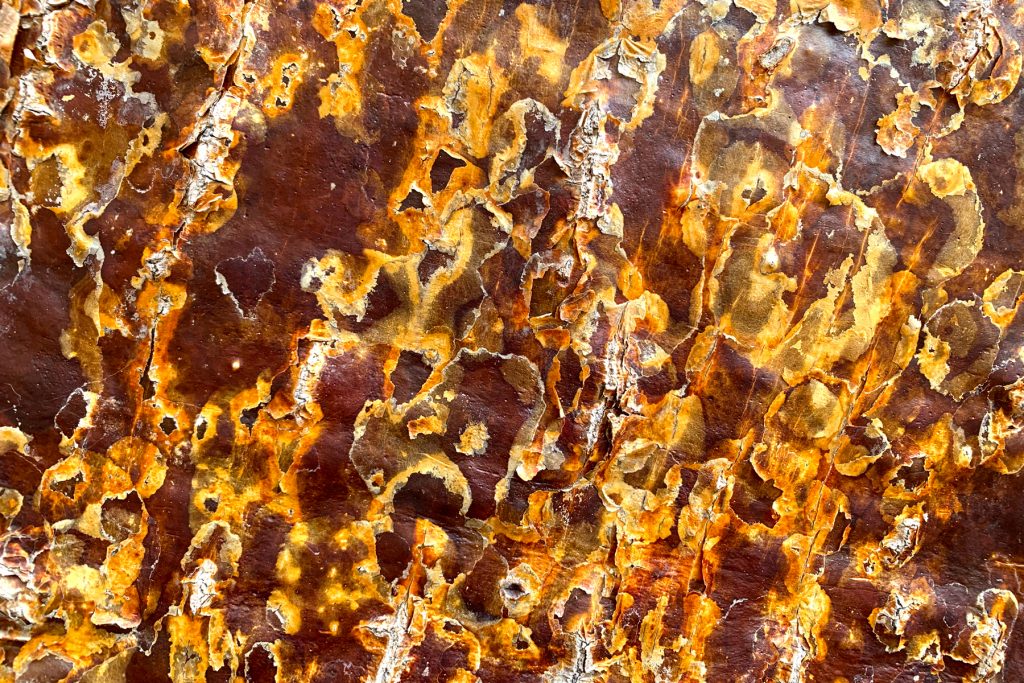
Fony Baobab bark (image by Mike Watson)
In late morning we checked the saltpans at Mangily. Our local guide had already located a Madagascar Plover for us among the Kittlitz’s and White-fronted Sandplovers, which saved us some time. However, it was not very approachable, out on one of the few pans still holding water. Also here were Curlew Sandpiper, Common Sandpiper and Striated Heron. We headed off for lunch at Chef Freddy’s. Wow! That has got to be the best seafood platter I ever saw with lobster, the peculiar rock shrimp, large Gambas shrimps, regular shrimps, crabs legs and fish piled high. The folks who skipped this session really missed out sadly, but the rest of us, including the drivers were happy to clear the plates.
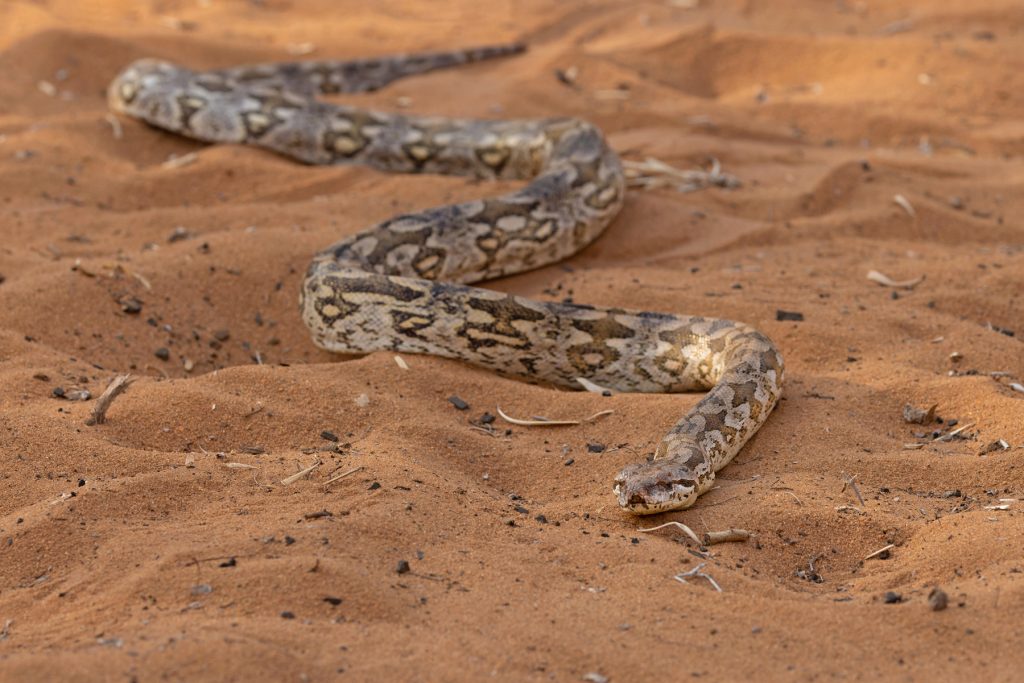
Dumeril’s Ground Boa is an apex predator of the spiny forest of Madagascar’s far southwest (image by Mike Watson)
We returned to the spiny forest reserve from last night for a daytime walk and were rewarded with an audience with a large Dumeril’s Ground Boa, one of our most wanted! It is an apex predator of the spiny forest and is capable of swallowing adult Ring-tailed Lemurs! A couple of gorgeous Spider Tortoises added some spice to the walk and we had better, daytime views of the ‘Ifaty’ Sportive Lemur and Lesser Hedgehog Tenrec again. A huge Hissing Coackroach brought the session to a close – although they are not usually universally popular and some of us boarded a zebu cart for a quick ride to our night walk spot back with the ground roller boys.
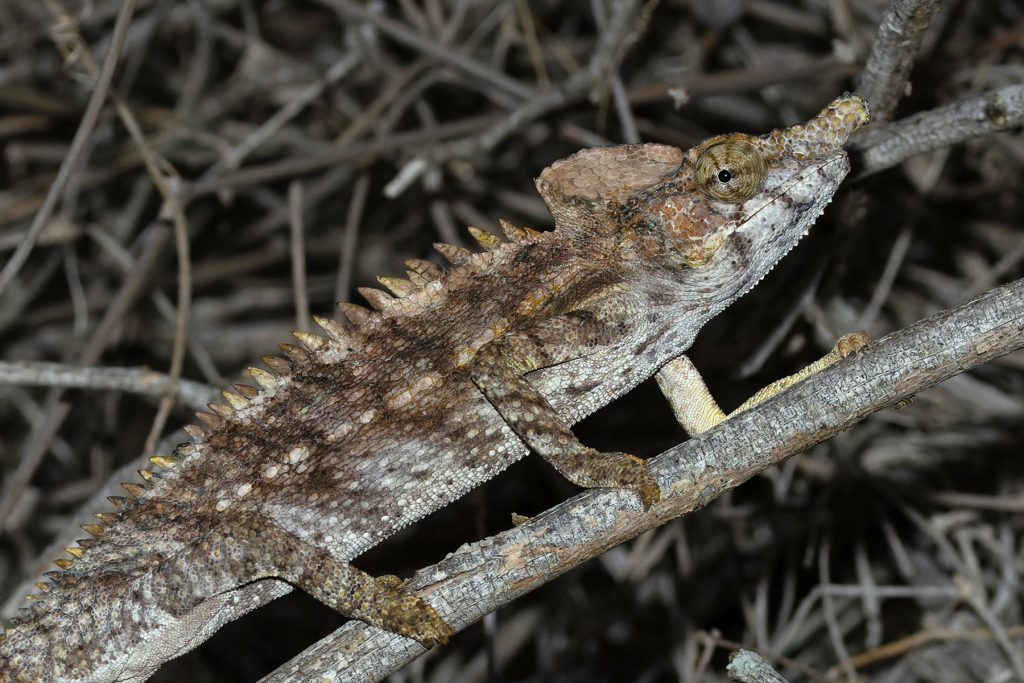
The prehistoric-looking Antimena Chameleon (Furcifer antimena) is a denizen of the spiny forest of Madagascar’s far southwest (image by Mike Watson)
They scored very quickly with a terrific Antimena Chameleon, the restricted range chameleon with huge dorsal spines, what a beast! Torotoroka Scops Owl was a little shy but we already had unbeatable views of that one at Kirindy. We had some more nice looks at the ‘Ifaty’ Sportive Lemur and our best Lesser Hedgehog Tenrec so far but first prize again went to Dumeril’s Ground Boa, an even bigger snake than the afternoon sighting. It was rather active, probably hungry, so we made do with some head shots of this monster. It was again very humid this evening and with clouds to the west there was no sunset today, just a red-orange glow. Finally, a nightjar greeted our return to our lodge, after a spectacular day in one of the most fascinating ecosystems on earth.
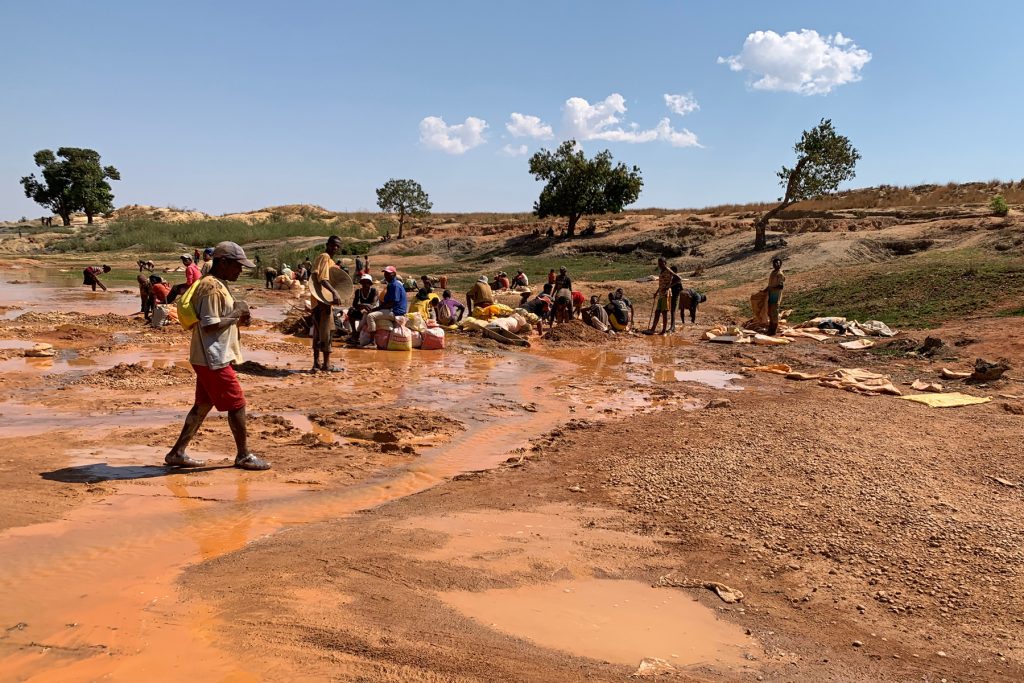
The Wild west of Madagascar is still experiencing a Sapphire rush, these people are panning for them in a roadside riverbed (image by Mike Watson)
It was time to hit the road again, this time we headed inland to the east and towards the sandstone canyons of Isalo. We made rather slow progress on the road, which has deteriorated since my last visit. The heat was also turning up as well towards 40 degrees and the air through the car windows felt like a hair dryer. Thank goodness for air con. We had a lot of fun in the lead vehicle today, with rock’n’roll Ronny on board. Eventually we reached the forest strip at Zombitse but we were way too late for any acceptable photographic light in the middle of the day. A lovely Standing’s Day Gecko was in a tree next to the national park booth and just across the road a family of Verreaux’s Sifakas was resting under the shade of the canopy. Our guides also had a pair of roosting White-browed Owls to show us but they were rather obscured high up in the tree. We saw three Oustalet’s Chameleons, including one poor moribund animal, which could no longer even hold onto a tree branch. Cuckoo Roller performed its defeaning songflight overhead and a Giant Coua showed well on one of the forest trails. We drew a blank with the rather nondescript endemic bird of this tiny forest strip, Appert’s Tetraka but we did see the endemic mammal, Zombitse (or Hubbard’s) Sportive Lemur, poking its head out of a roosting hole, jack-in-the-box style. Passing through several sapphire mining towns of Madagascar’s Wild West we finally rolled up at the amazing Isalo Rock Lodge. We were so lucky to have avoided a bush fire that had burned to the edge of the lodge’s canyon two days previously and singed many of the lovely Bismarck Palms immediately to the west. Thankfully the vicinity of the lodge and surrounding rock formations were still as pretty as ever. We had a leisurely afternoon followed by a sundowner in this idyllic location. The yellow flowers of Elephant’s Foot trees (Pachypodium rostulatum) were dotted around the canyon, as the creeping evening shadows eventually gave way to moonlight.
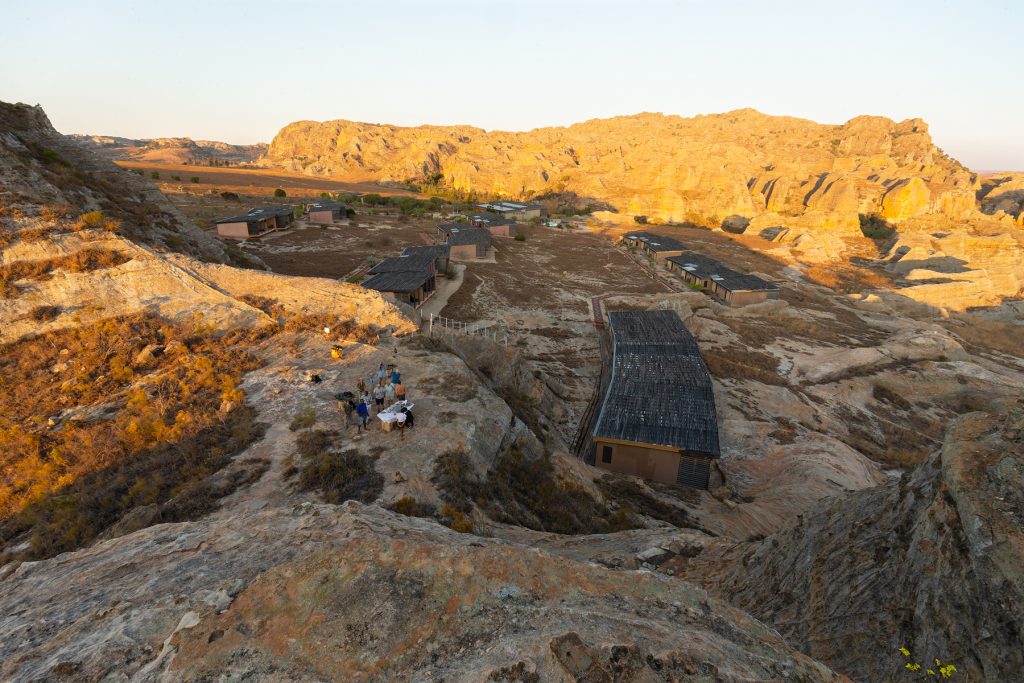
Isalo Rock Lodge – what a location for a sundowner! (image by Mike Watson)
Isalo National Park is home to the next iconic Malasgasy animal on our wish list, Ring-tailed Lemur. For someone who grew up watching Dottie the lemur and Johnny Morris at Bristol Zoo on the BBC’s Animal Magic TV programme when I was a child, a visit to Madagascar without seeing one is just unthinkable. We picked up our terrific local guide, who turned out to have an encyclopaedic knowledge of the natural history of the park, and headed down into the usual shady canyon on the edge of the rugged sandstone massif that is Isalo. We were treated to a very wide array of wildlife, some of which was photogenic. We started with macro critters including the bizzare Net-casting (or Ogre-faced) Spider (Deinopis madagascariensis), Common Big-eyed Snake (Mimophis mahfalensis), found by Ronny = another bootlace snake plus several black scorpions and stick insects. Birds included the noisy Cuckoo Roller again, Olive Bee-eater, Malagasy Coucal, Madagsacar Hoopoe, Madagascar Turtle Dove, Benson’s Rock Thrush (female) and (again) obscured, roosting White-browed Owl. A couple of Oustalet’s Chameleons were tallied but the highlight was of course the Ring-tailed Lemurs, a family of which allowed some very nice views around the picnic area in lovely dappled light at times. Probably my best encounter with them to date, although a couple of the (older?) animals were a little mangy. We explored a little further upstream where Green Lady butterfly (Graphicum cyrnus) was taking salts from the sandy water margins and had a lovely picnic by the rushing cascades.
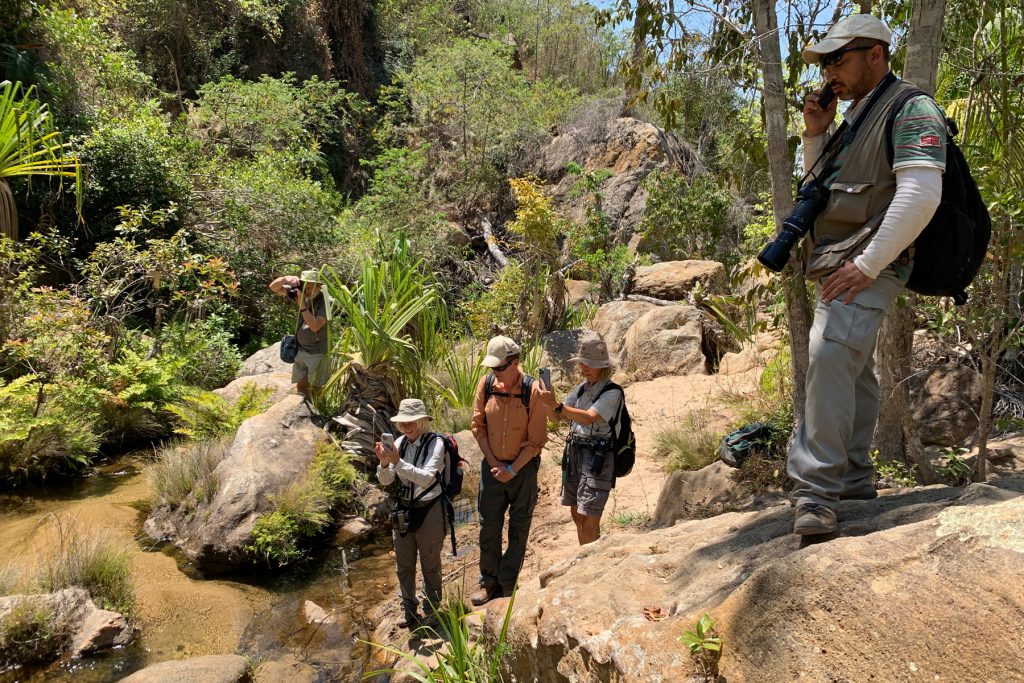
Wild Images group at Isalo National Park (image by Mike Watson)
Our journey back to Toliara in the afternoon was rather slowed down by the four sapphire mining towns we had to pass through, as well as zebu carts, bicycles with reeds and detours around potholed sections of road. Before returning to Tana next morning, we had a few hours to kill near Toliara, which we spent up on La Table bushlands. Although we saw the two main endemic birds here, Red-shouldered Vanga and Verreaux’s Coua, both were not very co-operative and we are finding the distance we need to cover to get into their habitat increases each year owing to wood-cutting for charcoal. Our bus was waiting for us in Tana and then started another tedious road journey to the eastern rainforests of Andasibe. We were very glad to reach our accommodation and see they had kept their kitchen open for us!
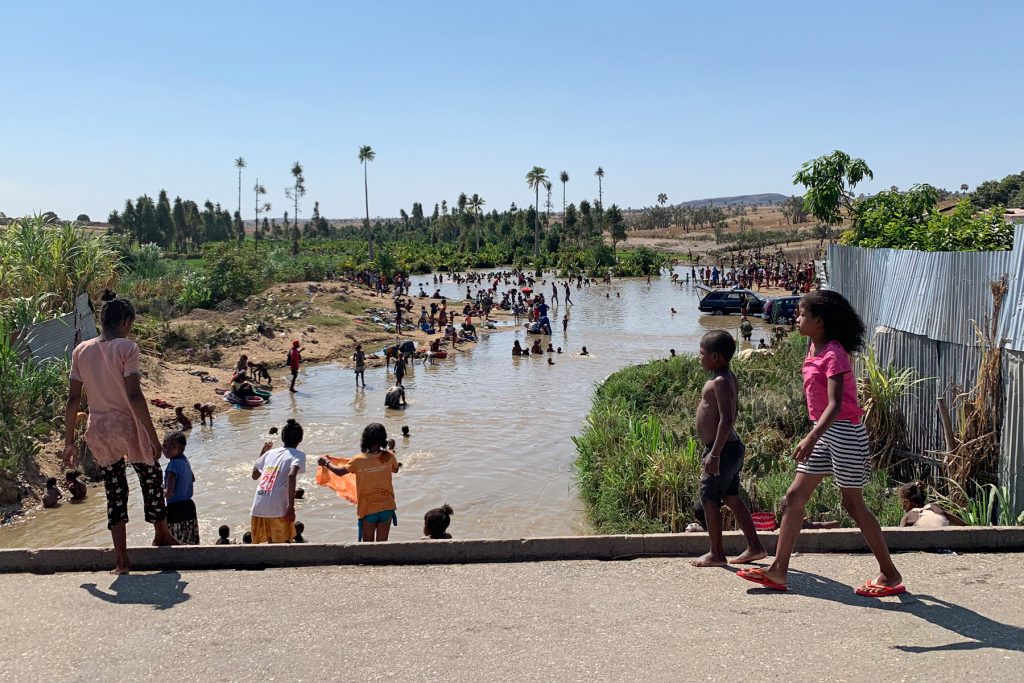
It’s bath time in Madagascar’s wild west (image by Mike Watson)
Not all of our crew wanted to endure the two hours bumpy jeep track to our next destination, the fabulous primary rainforest of Mantadia National Park. Those who did were rewarded with some nice looks at five of the critically endangered Black-and-white Ruffed Lemur, of the southern, white-rumped editorum subspecies, high in the canopy among the orchids. Capturing images of this one was a little more challenging than usual but it is always a privilege to see it let alone photograph it. B&WRL was lost from nearby Analamazoatra in the 1980s and although it was reintroduced there in 2006, Mantadia remains a much easier place to see it. We also saw naturally occurring Brown Lemur and the beautiful Diademed Sifaka (we were the only group to see it today) here but they too were more shy than usual. Birds were few in the quiet forest but our guide did find us a pair of Scaly Ground Rollers, one of the most sought after of all Malagasy birds! A Spectacled Tetraka on its nest was also very nice. The rest of the list included Greater Vasa Parrot, Blue Coua, Cuckoo Roller (up to 5 together overhead!), magpie robin, Long-billed Tetraka, Common Newtonia, Red-tailed and Blue Vangas of note. There were a few butterflies in the forest and we saw the huge Malagasy Mother of Pearl (Protogoniomorpha duprei) as well as Madagascar Forest Nymph (Aterica rabena) skipping between the forest giants and the small un-named satyr Strabena triopthalma along the main track. We were back in time for a night walk, starting with an appointment with a barn owl that followed a flurry of bats out of its roost in some old buildings right on cue, and perched in the nearby forest before it went off hunting. New lemurs for our trip list included Peyriera’s Woolly Lemur, Greater Dwarf Lemur and Goodman’s Mouse Lemur but none were within acceptable range of the cameras.
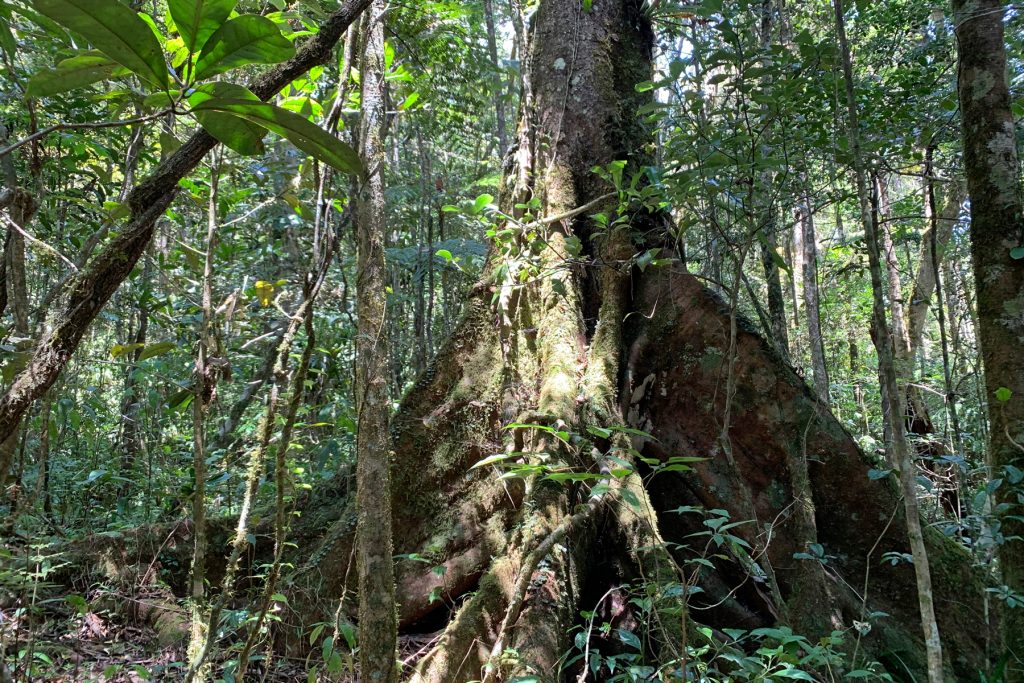
A buttressed forest giant in the primary forest at Mantadia National Park (image by Mike Watson)
We spent the following day in the secondary forest of Analamazoatra National Park, complete with the odd alien eucalypt and pine tree. It is still a pretty forest and produced the desired Indri photos! Although we even heard them singing from our lodge getting a clear view through the forest canopy, with other groups of vahaza wanting to do the same can be tricky. Eventually we managed some decent images and then we were called away for something special. Our guide was tipped off about a family of Diademed Sifakas on the forest floor not far away. We enjoyed some great views of this superb creature, the youngsters were quite playful and tumbled around, that is until the rest of the vahaza arrived and they moved away into the trees. Diademed Sifaka was lost from Analamazoatra in the 1970s but was reintroduced in 2007 and seems to be doing well. We also saw Brown Lemur and Gray Bamboo Lemur this morning, both of which were tricky to get an image of, before it was time for lunch.
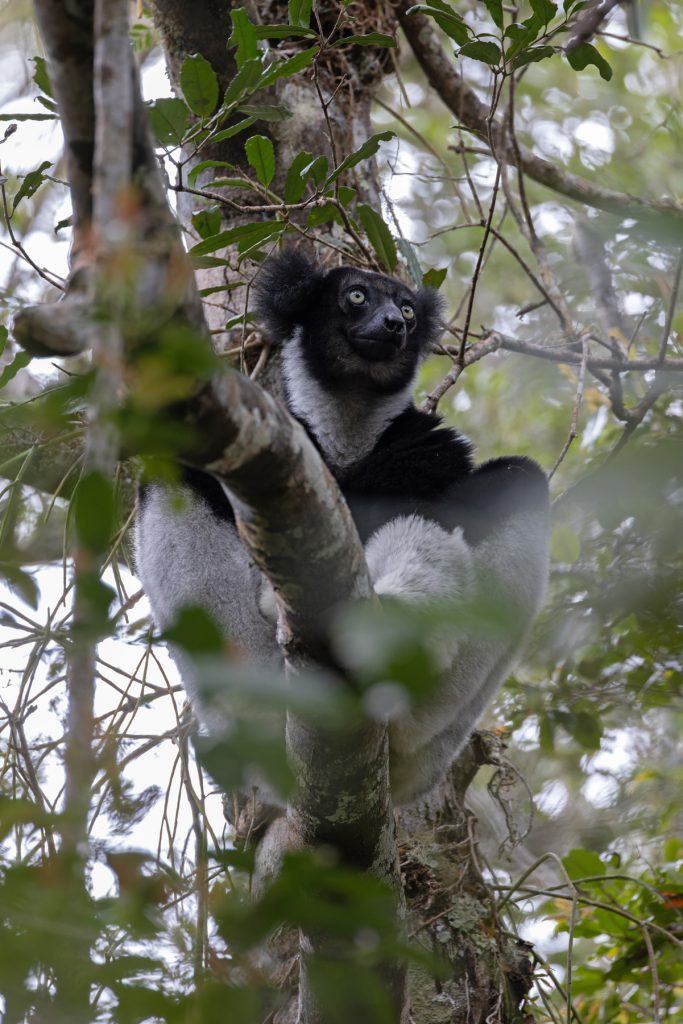
Indri at Analamazoatra – no visit to Madagascar would be complete without seeing this amazing animal (image by Mike Watson)
The afternoon session was really excellent. We visited the Parc Villageois V.O.I.M.M.A. community reserve, where our local guides had been hard at work in the morning locating animals for us. We started with some good views of Indri, this time more relaxed and resting in the late afternoon sun. A Nuthatch Vanga passed by while we watched the Indris. Next up was a roosting pair of Collared Nightjars, again expertly located, sleeping cheek to cheek in the leaf litter. Almost impossible for a casual visitor to find! Not far away was another of our most wanted, Parson’s Chameleon, a male – the heaviest of all chameleons! It walked down a very photogenic branch towards us too. To end with we were shown a Mossy Leaf-tailed Gecko, another master of camouflage. In fact, looking at my photos much later I thought I must have been taking exposure test shots until I remembered the gecko.
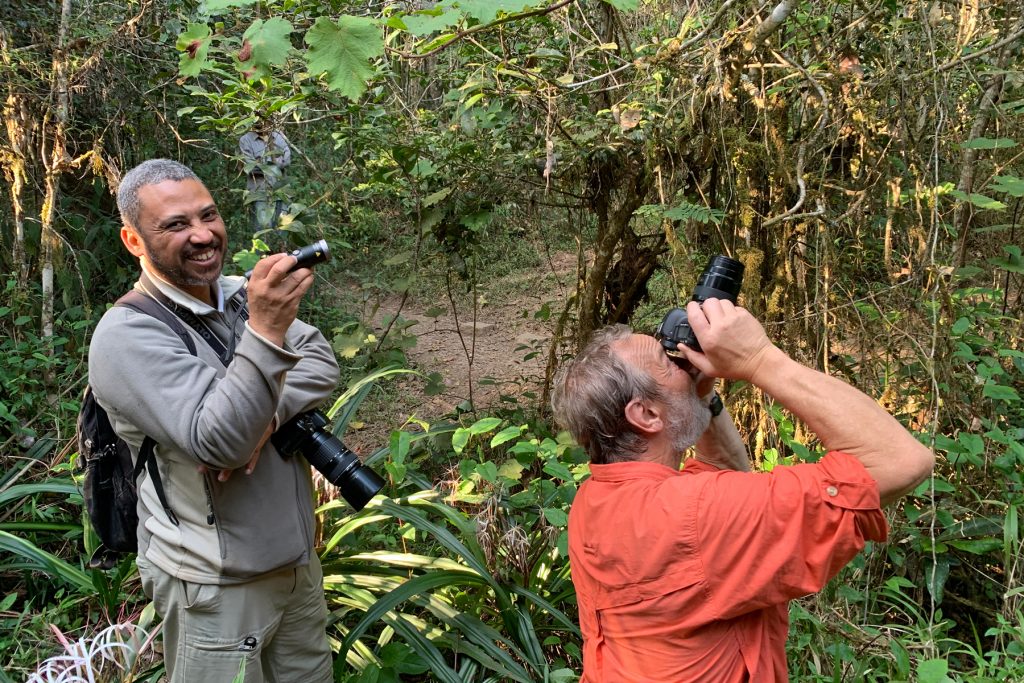
Fabrice adds a little light to the scene of some leaf-tailed gecko photography at V.O.I.M.M.A., Andasibe (image by Mike Watson)
We hung around until after dark and started our night walk here, with a female Parson’s Chameleon, a sleeping Indri and best of all, the fantastical Satanic Leaf-tailed Gecko – the one with the tail like a decaying leaf. After this awesome start we continued along the road back towards Analamazoatra and added Goodman’s Mouse Lemur and some very nice looks at Short-horned (or Elephant-eared) Chameleon (Calumna brevicorne). What a day! We had now seen a very nice selection of eastern rainforest creatures!
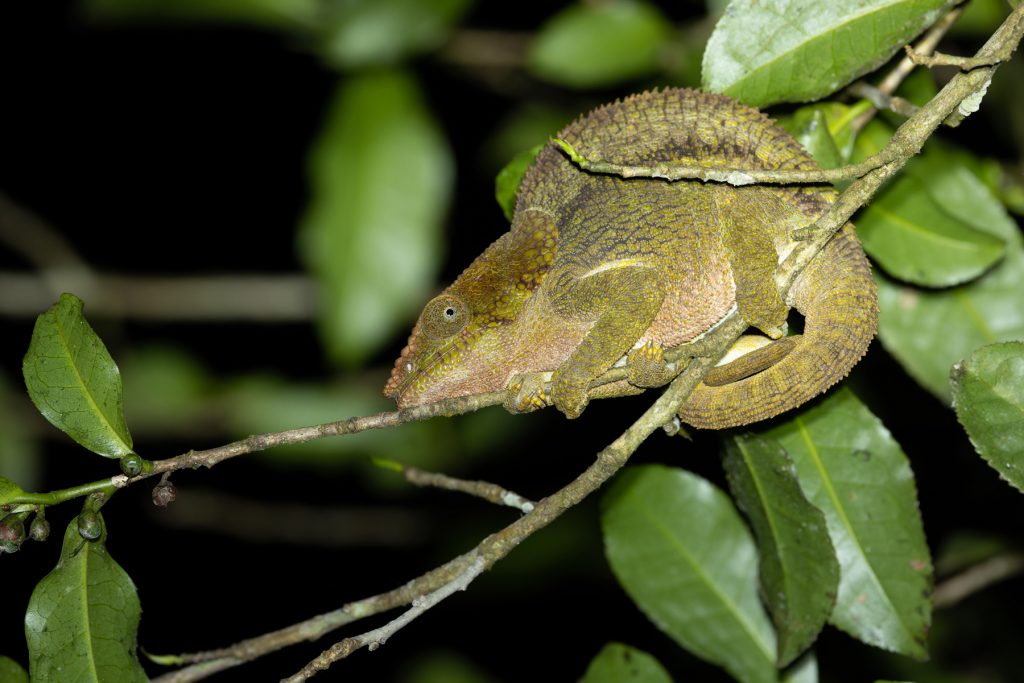
Elephant-eared (or Short-horned) Chameleon (Calumna brevicorne) on a roadside night walk at Andasibe (image by Mike Watson)
Andasibe sits close to the watershed of Madagascar’s spine and not far to the east of there, we were soon descending out of the native rainforest and towards the east coast. After several hours of overtaking lorries and then bumping along another jeep track, we eventually rolled up on the shores of Lac Rasoabe, where a boat was waiting to take us to our next destination, the gorgeous Le Palmarium. Birds were few along the side channels that took us north, just inland of the beach and we passed the famous Aye-aye island, the reason for our visit to this remote spot. We would return there after dark.
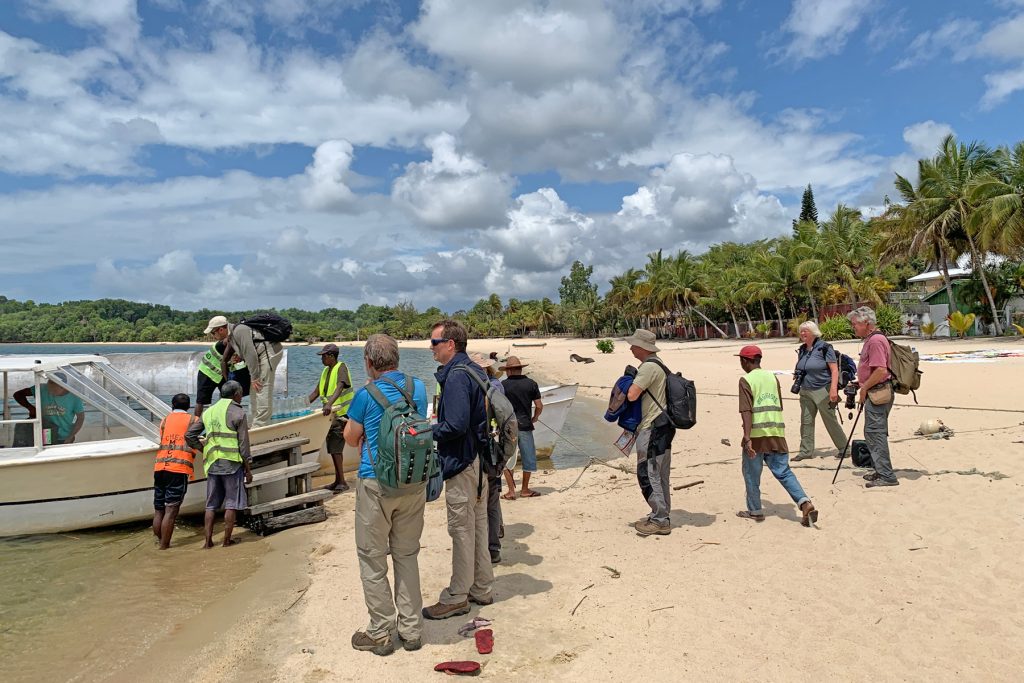
Wild Images group boarding the boat to Le Palmarium (image by Mike Watson)
After lunch we could explore the grounds of Le Palmarium. As well as being a transplanted lemur asylum (which does offer some great portrait opportunities in a zoo-like setting of Indri, including dark morph, Black-and-white Ruffed (of the ‘white-belted’, northern subspecies subcincta), Crowned, Brown, Red-bellied plus also several weird looking hybrids) the grounds of the lodge have some excellent naturally occurring creatures. Our walk produced Parsons’s Chameleon (of the slightly smaller parsonii form), Panther Chameleon (a subadult), Forest Night Snake (Ithycyphus goudoti) and plenty of the lovely little satyr butterfly Heteropsis fraterna. Late in the afternoon we took the boat to Aye-aye Island and after disembarking at a small jetty and climbing 37 steps we entered the nocturnal world of its namesake. Immediately on arrival a bushy-tailed Aye-aye was in full view, eyes ablaze, hacking into a coconut, wedged tightly between two tree trunks, with its sharp front teeth and using its crazy, elongated middle finger to delve deep into the nut. There can be fewer weirder creatures on the planet. The huge gremlin ears and goofy looks do not help, it is regarded as sinister in Madagascar, and is widely persecuted as a result. It is said that if an Aye-aye points its middle finger, you are cursed to die! It drank the coconut milk, ate some flakes of the pith and was then attracted to some banana smeared by our guides on even closer tree trunks until it was within touching distance. I wasn’t expecting to have back off it! We saw another couple of Aye-ayes at the feeding stations and also a dwarf lemur. What a fabulous experience! The rain clouds that had been building eventually produced a serious downpour but not until after evening meal. The rain then hammered down on our roofs tonight. Whether or not the Aye-ayes are naturally occurring here is a cause of some debate (they are probably not?) but they are at least in-habitat and there’s nowhere else you can see them like this so reliably, so, for photographers, the effort to visit this beautiful remote spot is well worthwhile.
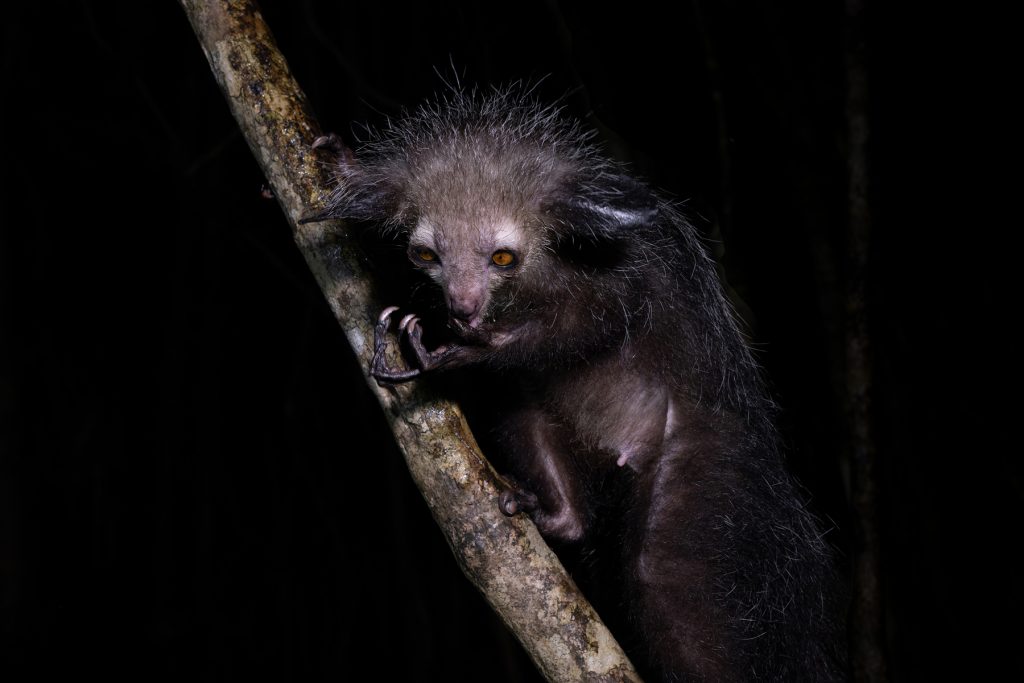
The Aye-aye’s middle finger is used for extracting invertebrates from within trees (image by Mike Watson)
Le Palmarium is such a wonderful place to spend time, nice chalets with the sound of waves lapping on the lake shore. We explored the surrounding forest more widely next morning finding a Malagasy Cat-eyed Snake (Madagascarophis colubrinus) resting in the fork of a palm and a gaudy Lined Day Gecko of note plus some wild-growing pitcher plants in a small marsh just inland of the beach. Butterflies included some lovely views of Madagascar Forest Nymph again. It was pretty hot this morning so we tried to stay in the shade where possible! In the afternoon we had a couple of small chameleons – one Panther and an Oustalet’s. A second visit to Aye-aye Island was very useful, with four Aye-ayes seen this time and another chance for anyone who wanted to try some different camera settings. ISO6400 on the Canon R5 produced some lovely noiseless images in the torchlight, with a little help from DXO of course!
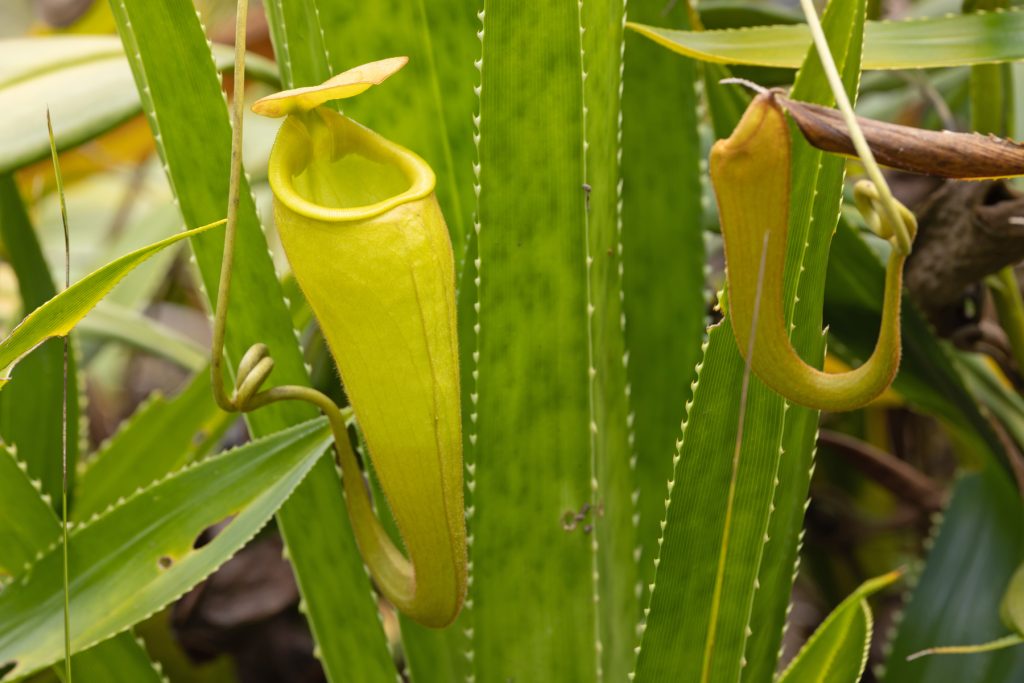
Pitcher plants growing in profusion at Le Palmarium (image by Mike Watson)
We thoroughly enjoyed our time at Le Palmarium and it proved a very nice respite from the rigours of road travel over the last couple of weeks, surrounded by gorgeous animals. We still had to endure a long journey home though, starting with a day on the road back to Tana. The boat journey back to Lac Rasoabe produced some Striated Herons and Malagasy Malachite Kingfishers and we saw a Madagascar Pratincole from the coach while crossing a large river but that was about it and our wildlife tour of the ‘Eighth Continent’ came to an end. We will be back next year!
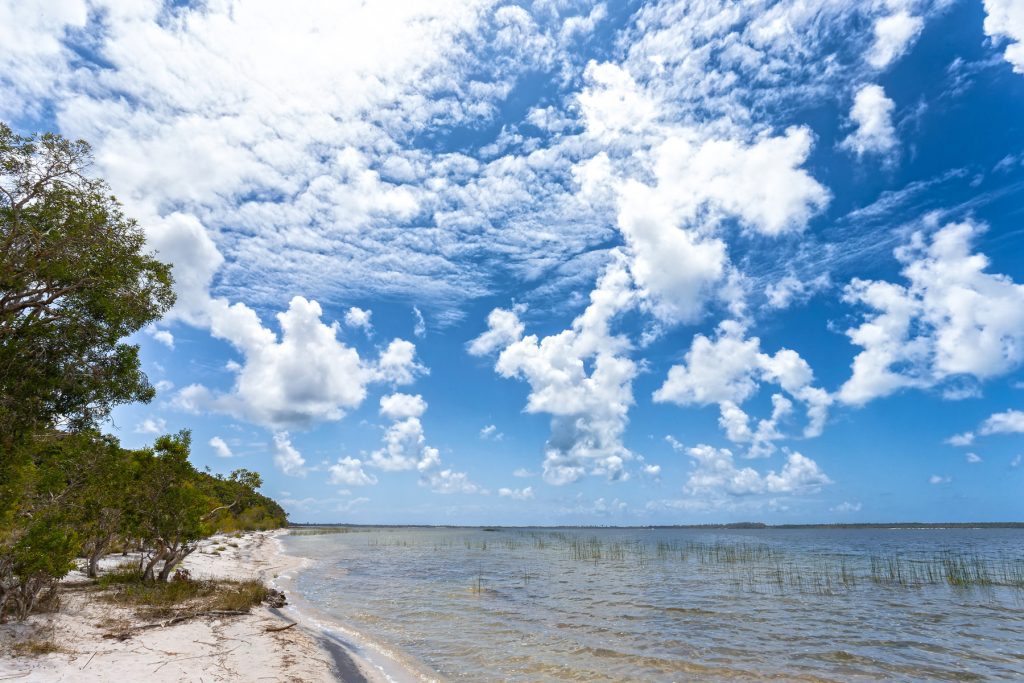
The white beaches and (usually) blue skies of Le Palmarium (image by Mike Watson)





























































































































